Spicy air-fried salmon and asparagus coated in a wet habanero adobo seasoning of paprika, onion, garlic, oregano, cumin, and lemon are then placed on top of a creamy bright yellow risotto seasoned with adobo spices and turmeric, creating a delicious salmon risotto dish.
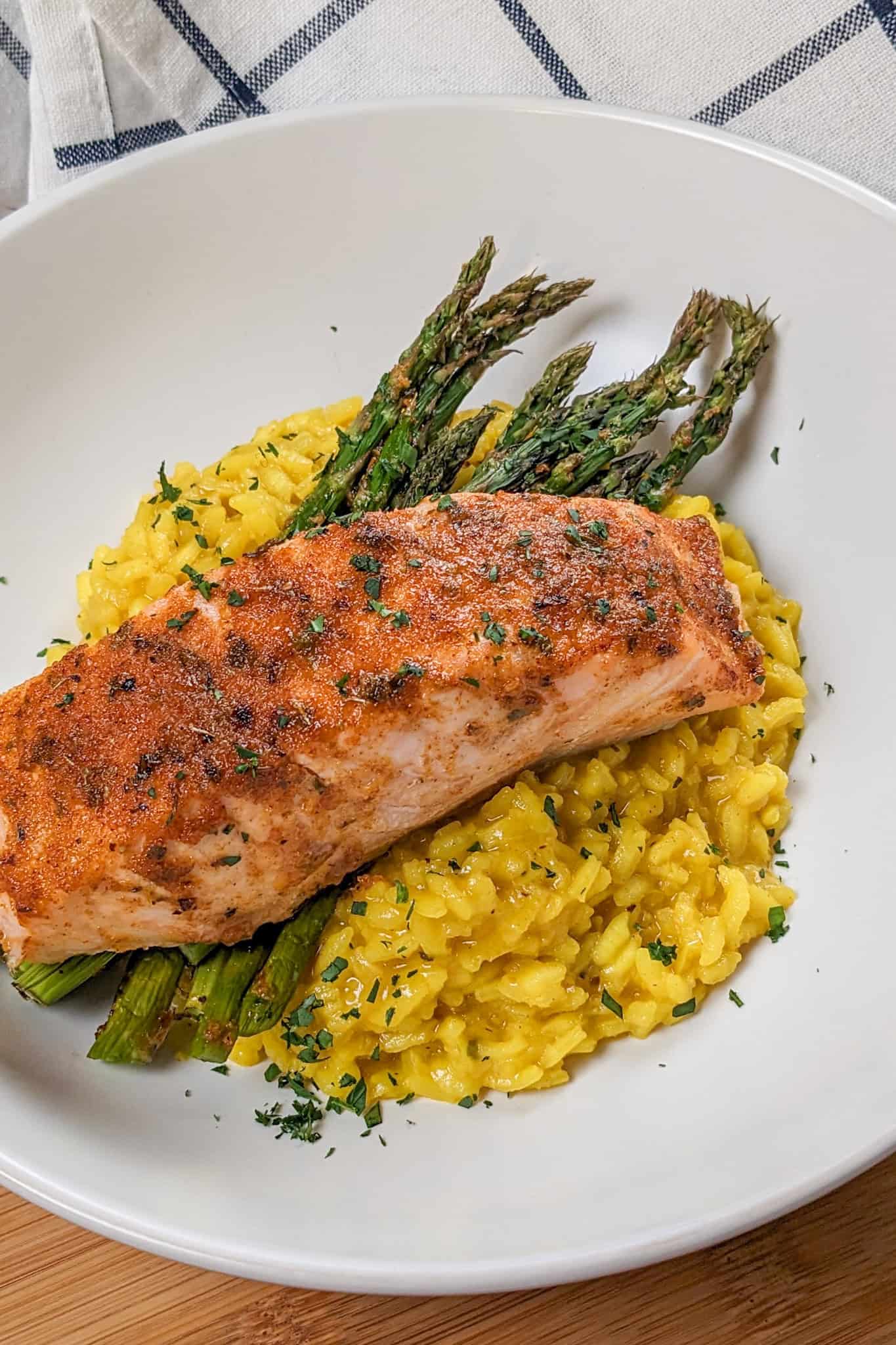
Table of Contents
Jump to:
- From Italy to the Caribbean
- The Habanero Pepper
- Arborio = Risotto
- Ingredients with Steps
- Culinary Glossary
- Instructions with Pictures
- Substitutions
- Variations
- Equipment
- Storage
- Cooking Tip
- Frequently Asked Questions
- Seafood Recipes
- Air Fryer Recipes
- 📖 Recipe
- Subscribe to my YouTube Channel.
- Have a Comment or Question?
From Italy to the Caribbean
Welcome to the latest culinary adventure, where we explore the vibrant and spicy flavors of the Best Air Fryer Habanero Adobo Salmon paired with Yellow Risotto. This easy weeknight dinner dish is a fusion of heat and comfort, featuring succulent salmon air-fried to perfection, marinated in a zesty habanero adobo seasoning blend that includes paprika, onion, garlic, oregano, cumin, and a splash of lemon.

Adobo Wet Seasoning is a marinade or sauce typically made by combining spices such as paprika, oregano, garlic powder, onion powder, cumin, salt, and pepper with wet ingredients like hot sauce, oil, and citrus juice. Used to flavor meats, poultry, or vegetables.
The salmon and crispy asparagus sit atop a creamy, bright yellow risotto bed. This isn't just any risotto - it's infused with Caribbean-inspired adobo spices and a hint of turmeric, giving it a distinctive color and a layer of earthy flavors. This meal is a perfect balance of spice and soothing creaminess, ideal for those looking to add a little excitement to their dinner routine.
The Habanero Pepper
The habanero chili has been used in cuisines around the world for centuries. It originated in the Amazon basin and eventually spread throughout Mexico and the Caribbean. The Mayans used it in traditional dishes, valuing its intense heat and fruity, floral aroma.
Over time, the habanero has become a staple in many different world cuisines, and adventurous chefs have embraced it for its ability to add a unique kick to any dish. Today, this chili pepper is used in traditional Latin and Caribbean dishes and creatively used in chocolates, jams, and cocktails, showcasing its versatility and enduring appeal in the global culinary scene.
A Hot Hot Pepper
I deeply love habanero peppers and their fiery, fruity heat. With a Scoville rating ranging from 100,000 to 350,000 units, these peppers pack a punch that elevates any dish. I often reach for either habanero or Scotch bonnet peppers, known for their high spiciness and vibrant flavors, to add a bold kick to my recipes.
Scotch bonnets, with a similar Scoville range of 100,000 to 350,000 units, offer a slightly sweeter profile that complements various cuisines. If you’re curious about the Scoville scale and want to explore the world of spicy peppers, be sure to check out my article on the Scoville scale and learn more about these fiery ingredients and others! Plus, you'll find photos of actual peppers from my own garden. I don't play! LOL
Arborio = Risotto
Arborio rice is a short-grain rice named after the town of Arborio in Italy's Po Valley, where it was first grown. It is ideal for making risotto because of its high starch content and firm texture. It absorbs liquids and flavors while maintaining a slight chewiness.
During cooking, it releases starch, which gives risotto its creamy consistency and makes it a classic Italian dish. Historically, risotto originated as a peasant dish in North Italy. The slow cooking and stirring process transformed simple ingredients into rich, luxurious meals.
Over time, risotto has evolved into a refined staple of Italian cuisine, with Arborio rice being an integral ingredient in countless regional recipes that celebrate local flavors and ingredients. It is a beloved dish known for its versatility and depth. If you are looking for authentic Italian recipes, I suggest you check out Inside the Rustic Kitchen and Recipes from Italy.
More Seafood-Inspired Recipes
- Spicy Creole Shrimp and White Cheddar Cheese Risotto
- Spicy Shrimp Farro Risotto with Mushrooms and Peas
- Air Fryer Spicy Cilantro Lime Salmon Salad Rice Bowl
- Air Fryer Calabrian Chili Salmon and Vegetables Bowl
- Calabrian Pepper Basil Baked Salmon and Broccolini
Ingredients with Steps
To prepare the dish, start by making the adobo wet seasoning by mixing paprika, oregano, garlic powder, onion powder, cumin, salt, and pepper, and adding habanero sauce, avocado oil, lemon juice, and zest, reserving some seasoning for the risotto. Prep the asparagus by trimming the ends and chop the shallot and garlic for the risotto.

Deglaze is a cooking technique where liquid, such as wine or broth, is added to a pan to dissolve browned bits of food, enhancing the dish's flavor.
In a Dutch oven, sauté shallot and fresh garlic, then add arborio rice, frying it with continuous stirring. Deglaze with white wine, then gradually add chicken broth mixed with turmeric, reserved adobo seasoning, kosher salt, and ground black pepper, absorbing each addition while stirring to release the starch.
Meanwhile, preheat the air fryer to 375 degrees Fahrenheit, and prepare the salmon filets and asparagus by drying the salmon, placing it in the fryer basket with asparagus, and brushing with the adobo seasoning. Cook until the salmon reaches an internal temperature of 145 degrees Fahrenheit, and finish the risotto by stirring in lemon juice, zest, and grated pecorino cheese, adjusting the seasoning as needed.
Culinary Glossary
This section provides concise definitions of key ingredients and techniques to enhance understanding and improve cooking skills related to this recipe. Check out the live Culinary Glossary here.
- Paprika: A spice made from ground red peppers, often used to add color and flavor to dishes.
- Oregano: An herb with a robust and slightly bitter flavor that is commonly used in Mediterranean and Mexican cuisines.
- Cumin: A spice made from the seeds of the Cuminum cyminum plant, known for its warm, earthy flavor and commonly used in Middle Eastern, Indian, and Mexican cuisines.
- Habanero Sauce: A hot sauce made from habanero peppers, known for its intense heat and fruity flavor. Learn more about habanero in the introduction section.
- Avocado Oil: A healthy cooking oil with a high smoke point, extracted from the flesh of avocados, often used for frying or dressing.
- Lemon Zest: The outer yellow skin of a lemon, which contains aromatic oils and imparts a fresh, citrusy flavor to dishes. Learn more about zesting here.
- Asparagus: A green vegetable with spear-like stalks, often trimmed to remove the woody ends before cooking. They come in two sizes: pencil and jumbo. Also, jumbo is great for grilling and roasting, while pencil asparagus is great for sauteing.
- Shallot: A type of onion with a milder flavor, often used in French and Asian cuisines.
- Arborio Rice: A short-grain Italian rice variety known for its high starch content, which gives risotto its creamy texture.
- Deglaze: A cooking technique where liquid, such as wine or broth, is added to a pan to dissolve browned bits of food, enhancing the dish's flavor.
- Turmeric: A bright yellow spice made from the root of the Curcuma longa plant, known for its earthy, slightly bitter flavor and often used in Indian cuisine. But it is used in this recipe as a color enhancer. Saffron and Annatto will also do the trick.
- Pecorino Cheese: A hard, salty Italian cheese made from sheep's milk, often grated over pasta and risotto dishes for added flavor, this cheese can sometimes be confused with parmesan cheese.
See the risotto asparagus air fryer salmon recipe card for quantities below.
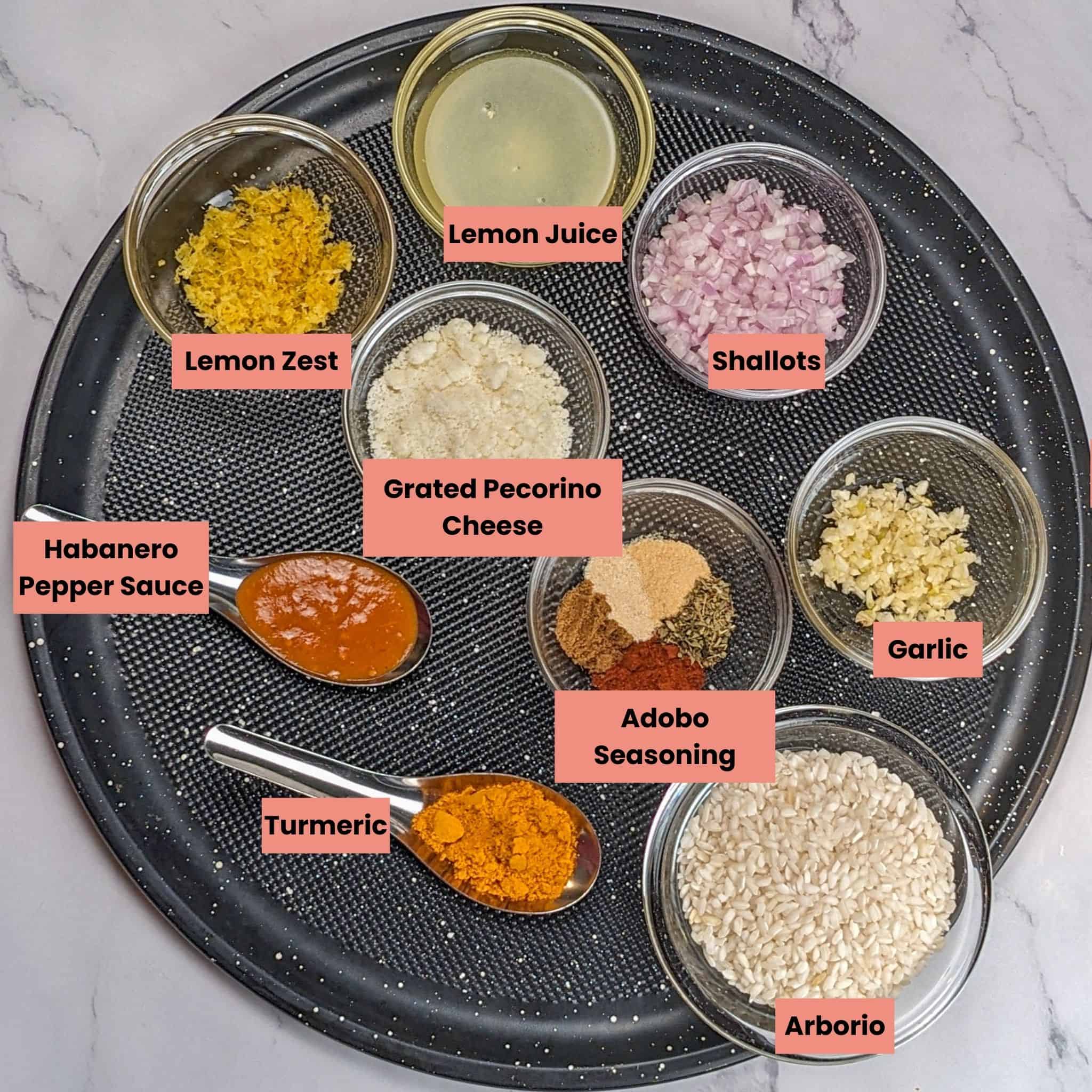
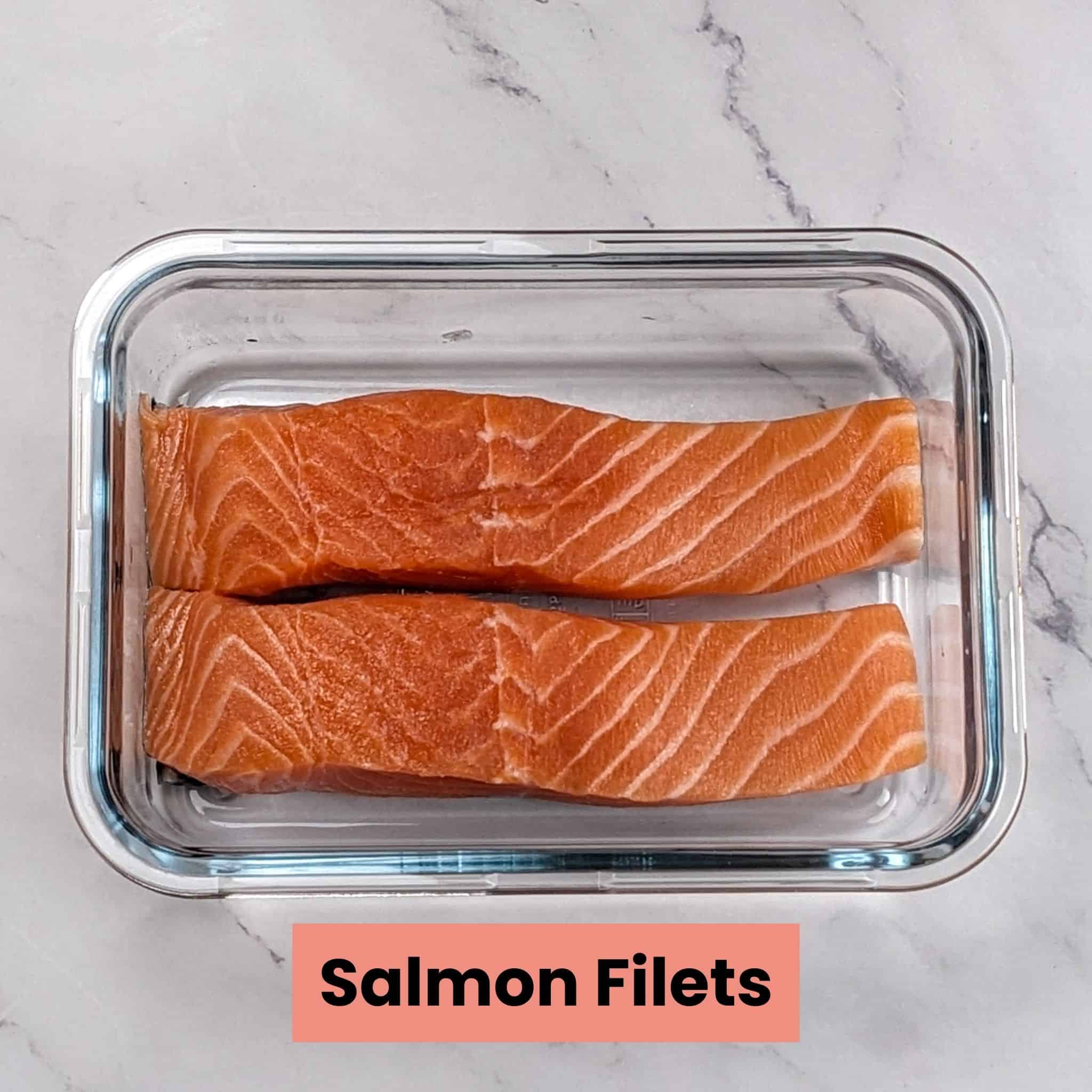
Instructions with Pictures
Follow the instructions and cooking tips below using the step-by-step picture guide.
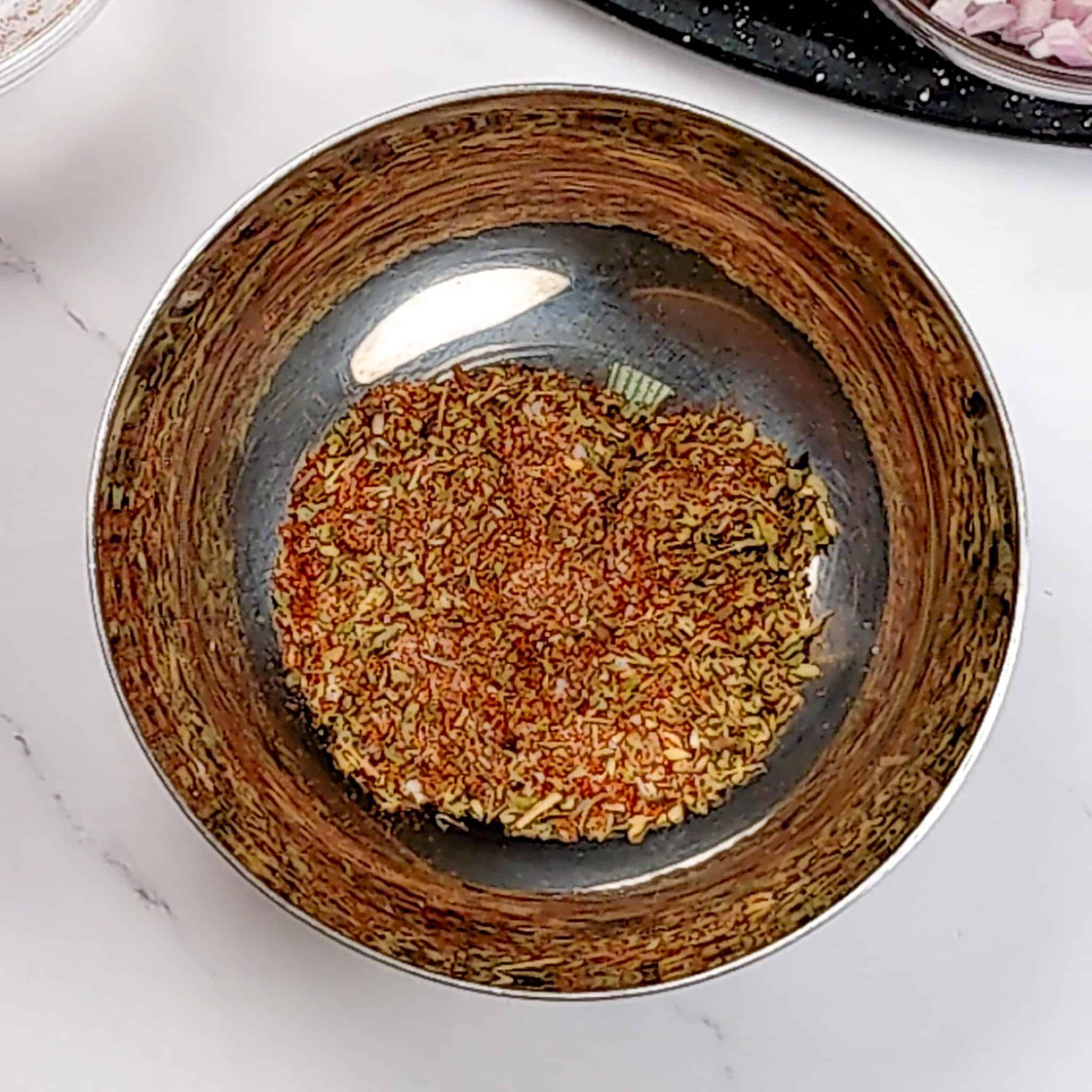
Follow the instructions and cooking tips below using the step-by-step picture guide. Making your season blend helps you control your salt intake by adding the desired amount.
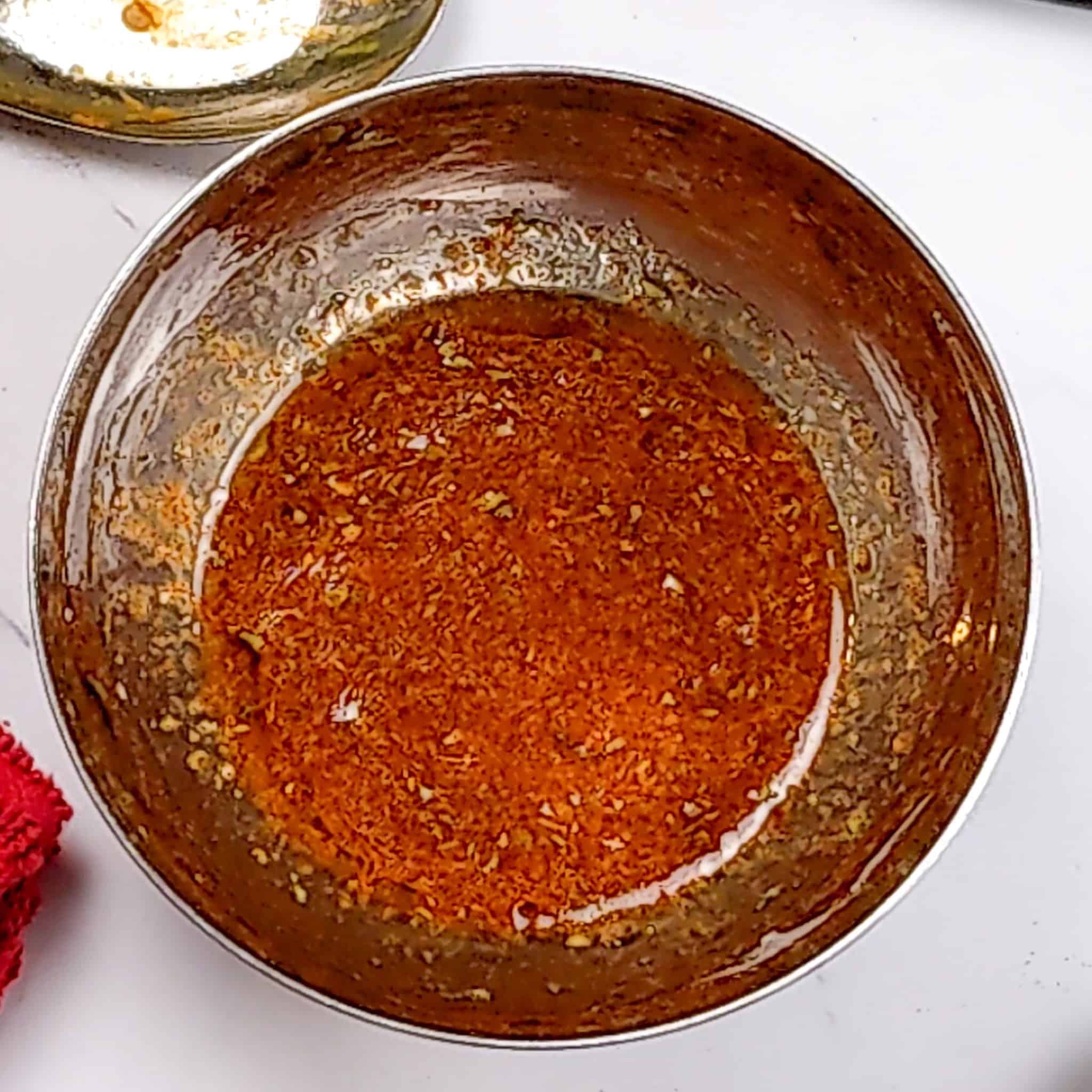
When making the wet adobo seasoning, use a high smoke point oil since it will be used on the salmon and asparagus in the air fryer.
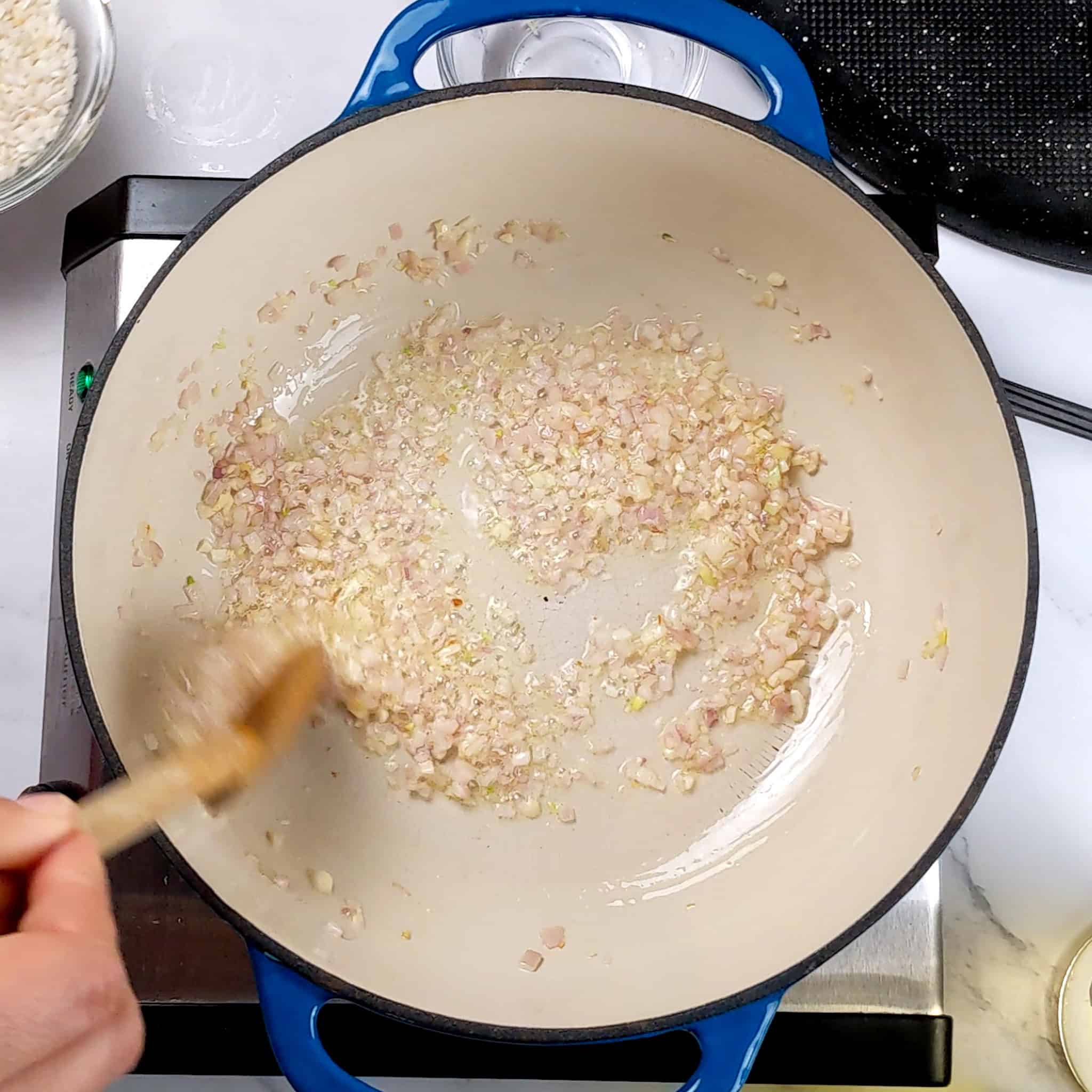
Finely chop the shallots and garlic, which are used for flavor, not texture.
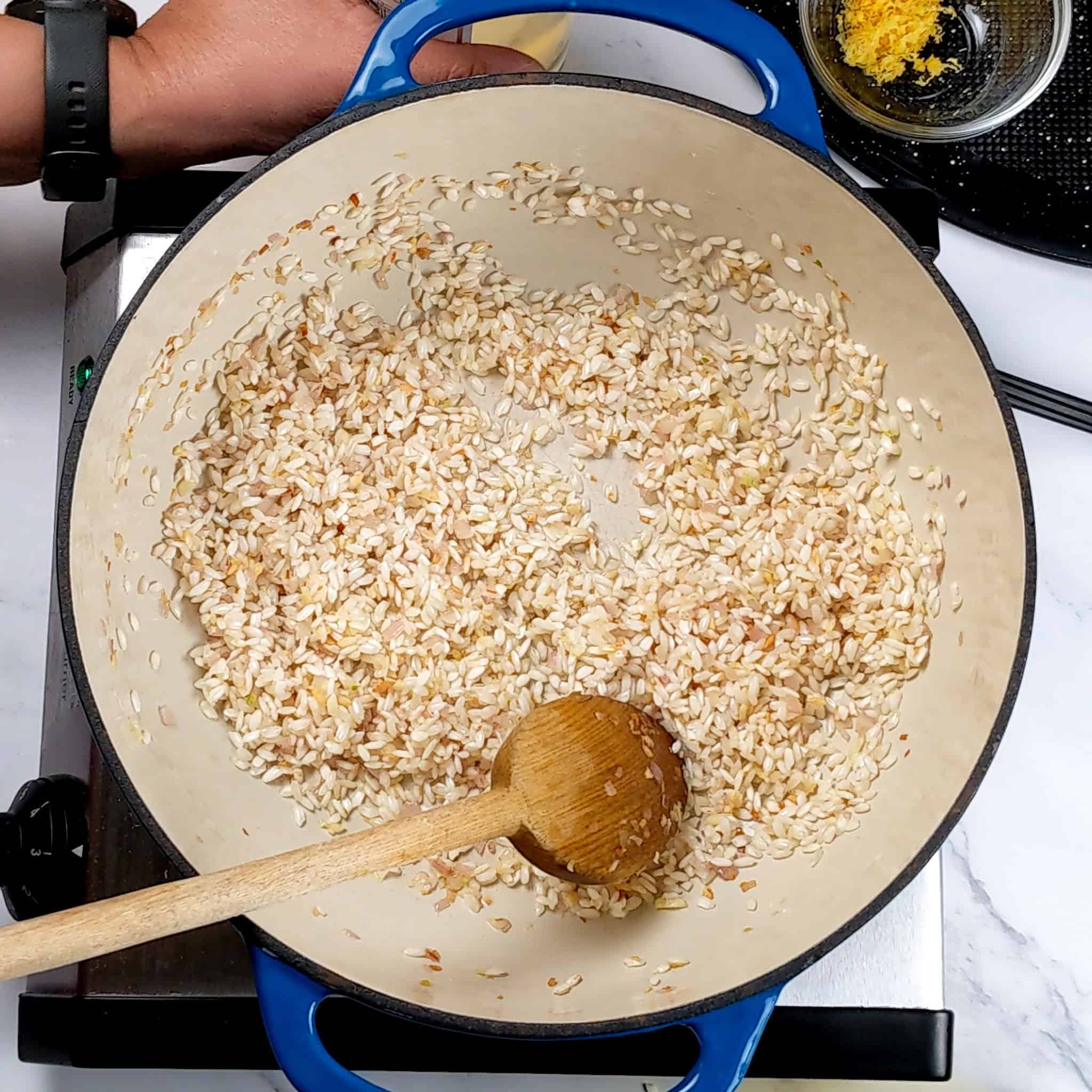
Toasting the rice before cooking can help to prevent it from becoming too mushy.
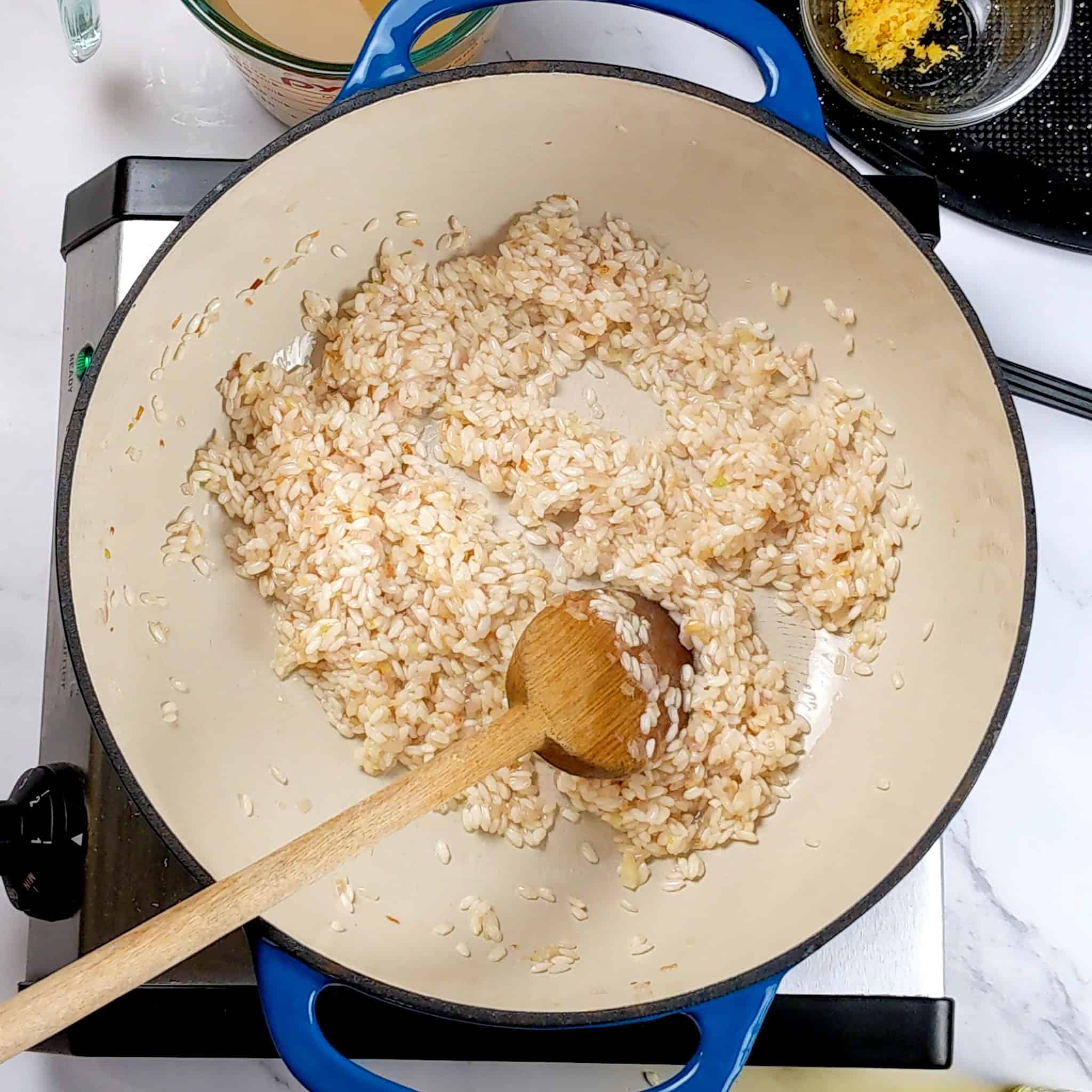
Add the wine and let the liquid evaporate while it flavors the rice.
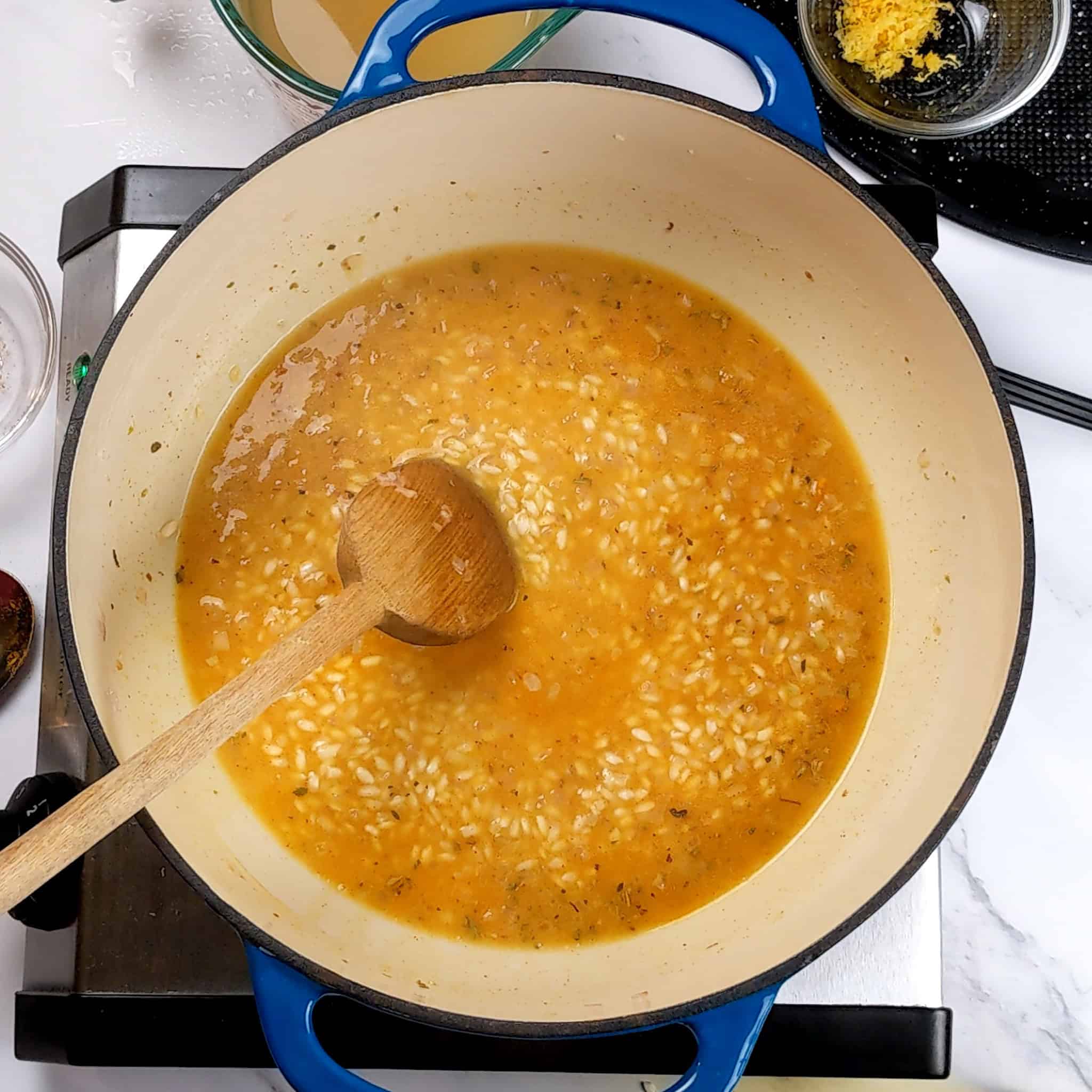
Start with half of the broth with turmeric and seasoning before adding more. You want the flavor to build up as the liquid is being absorbed.
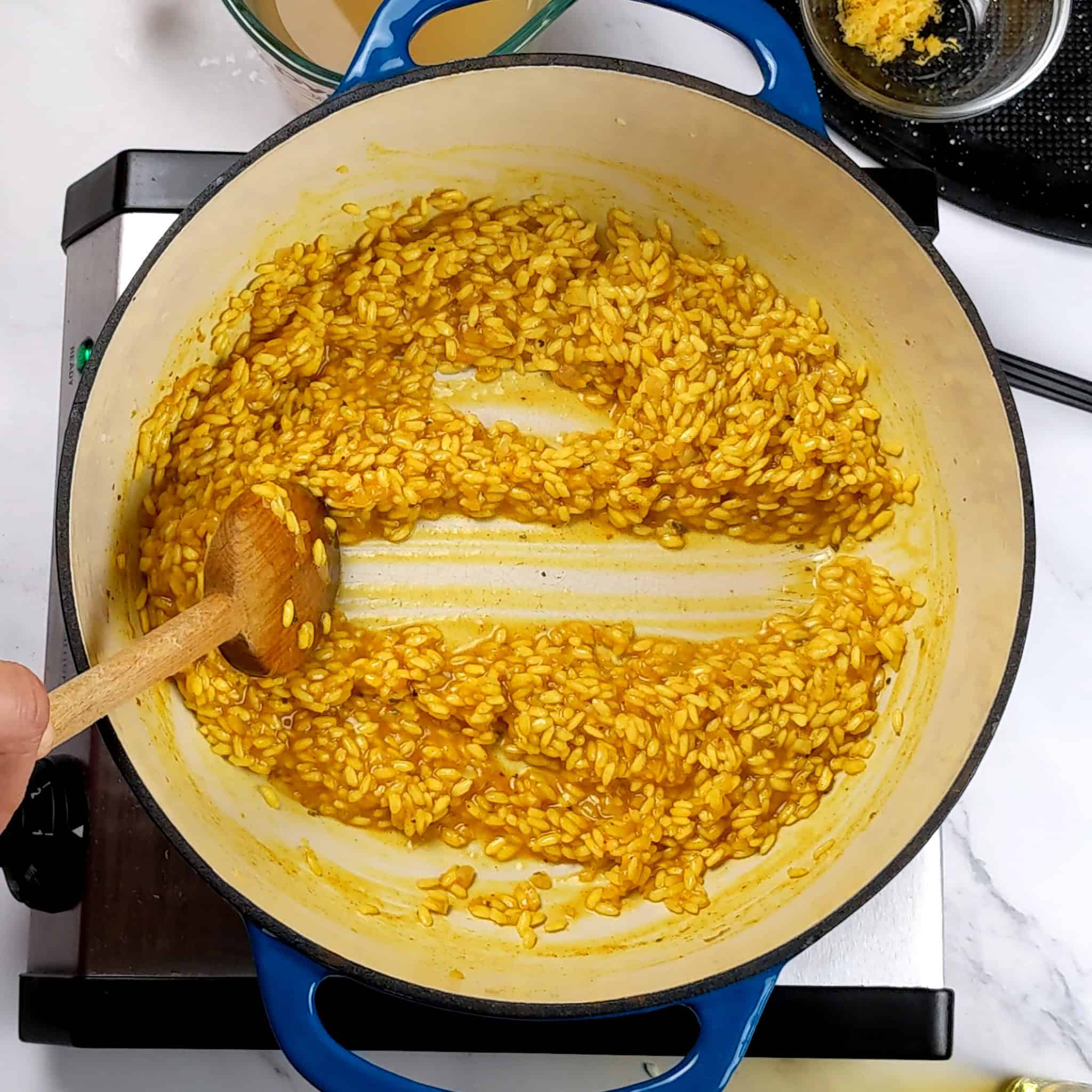
Before adding more broth, scrape the pot's bottom using the wooden spoon test. The liquid should return to the middle slowly.
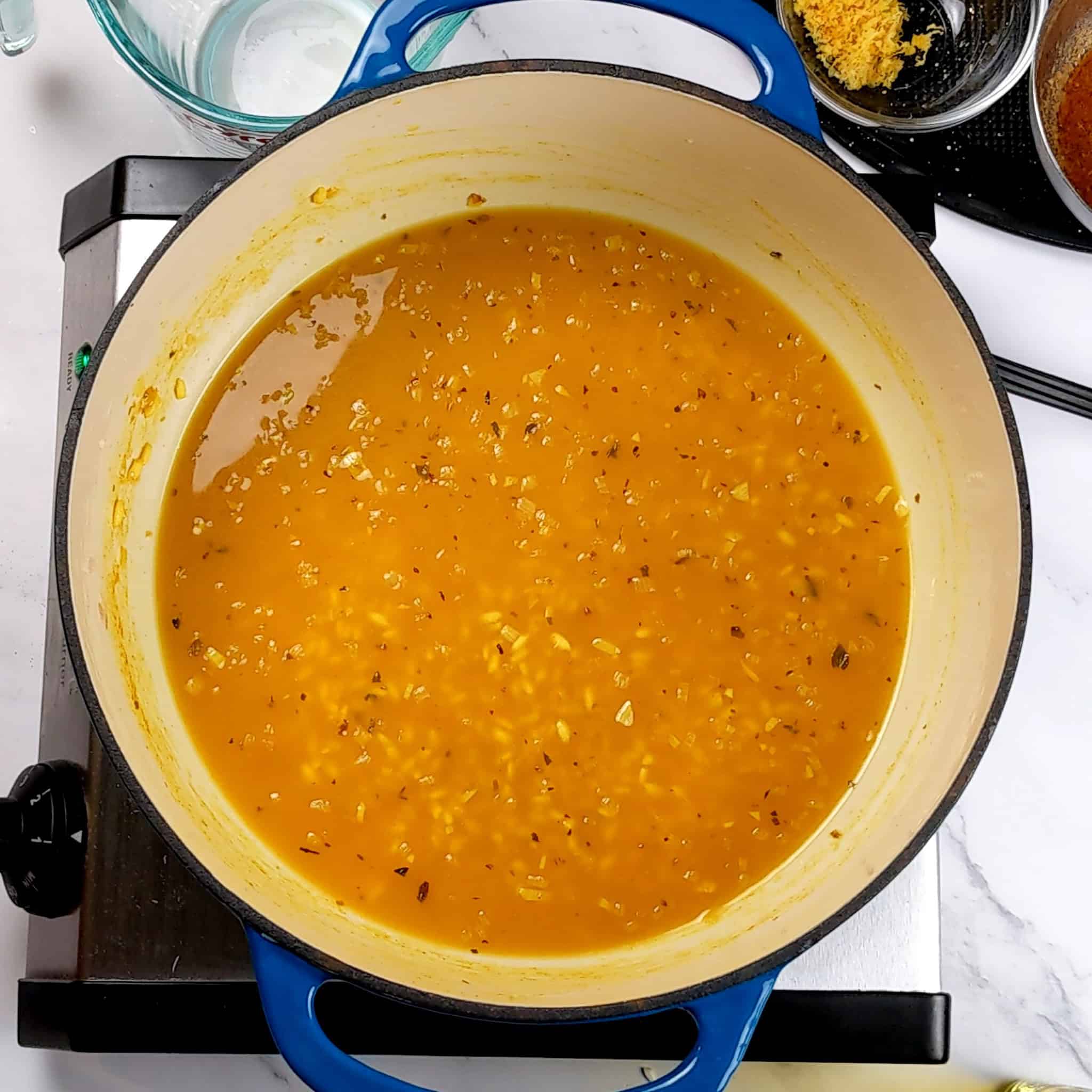
Add the next amount of broth, stirring occasionally to thicken the broth, and allow the rice to cook evenly.
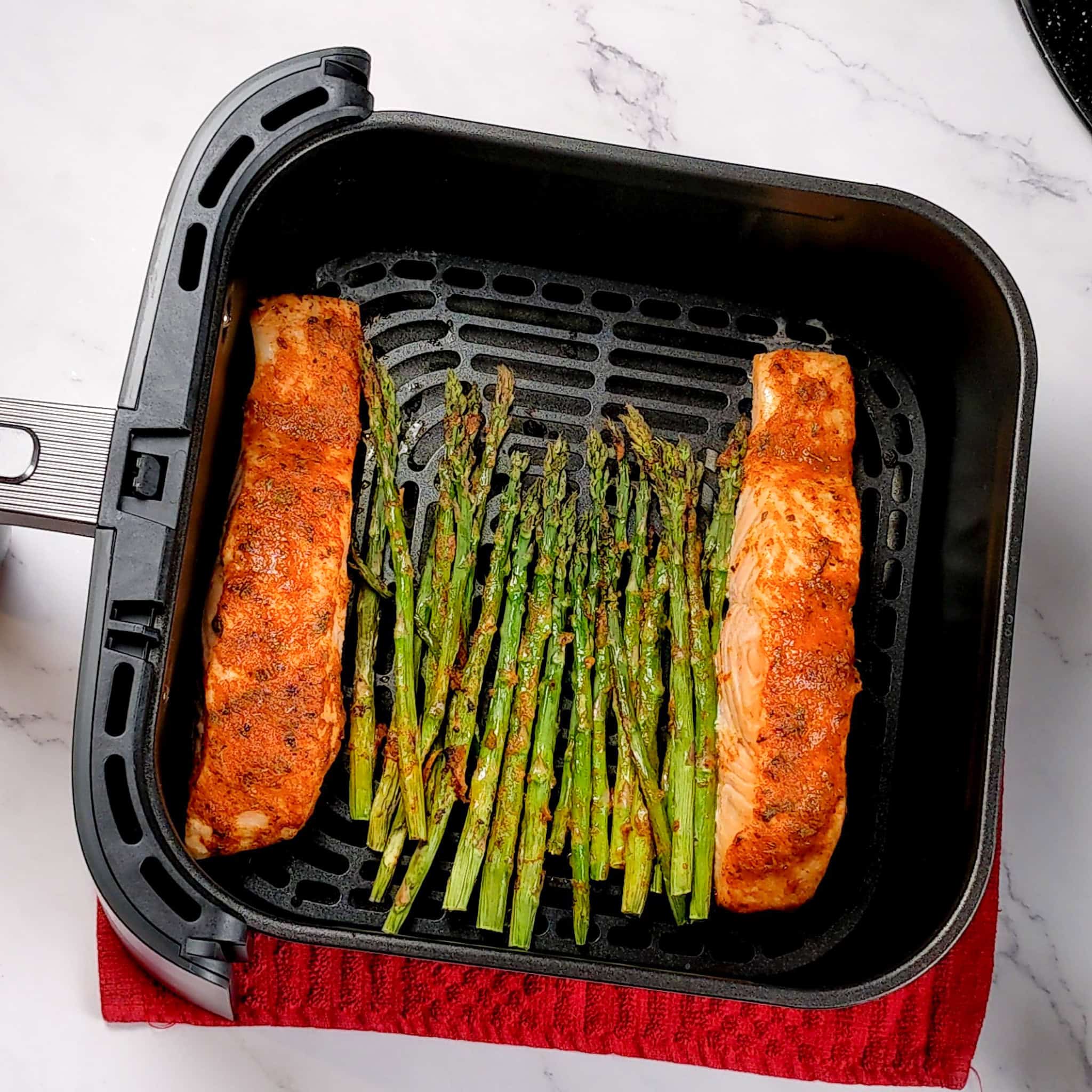
If necessary, use a meat thermometer to ensure the center of the salmon in the thickest area reaches 145 degrees Fahrenheit.
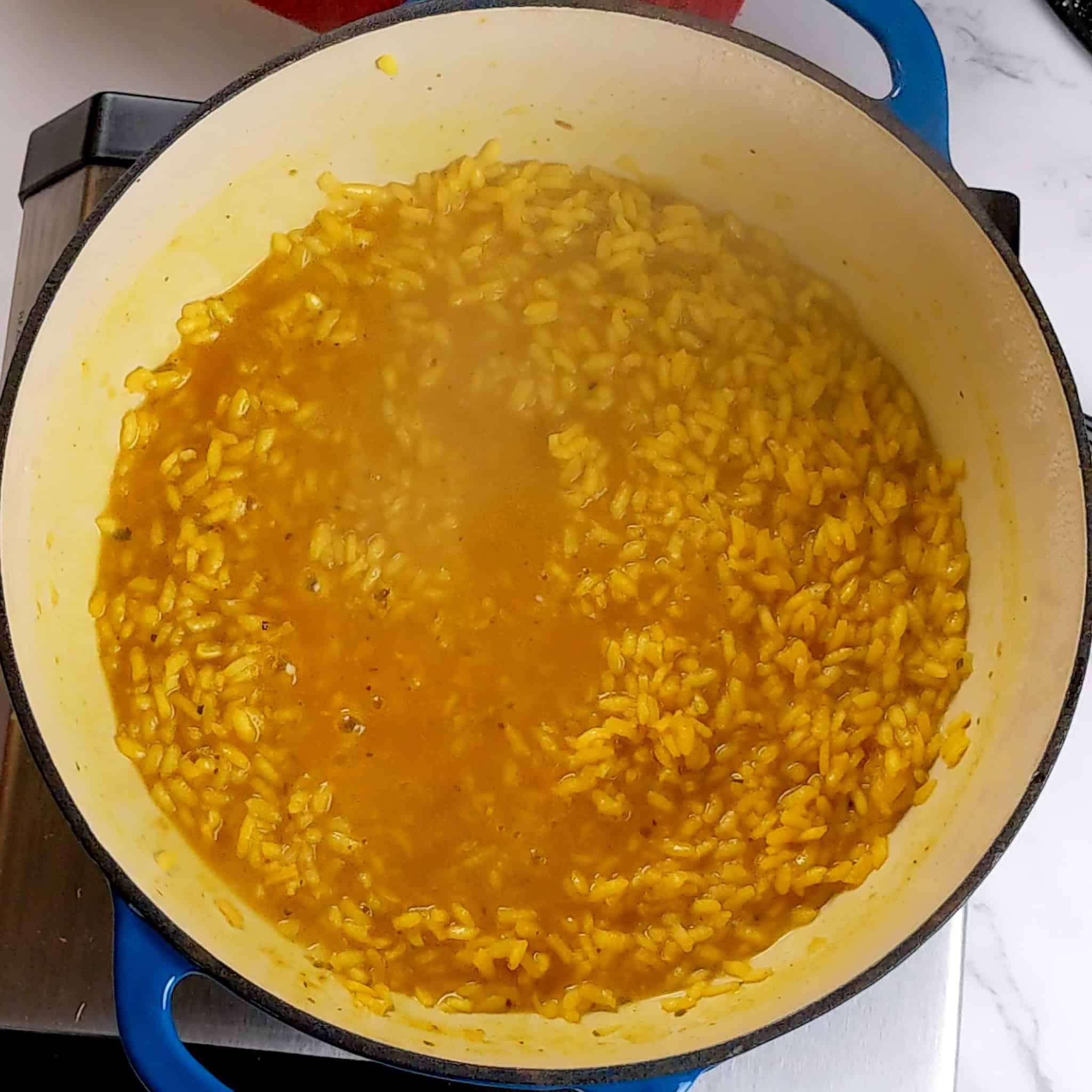
Add the rest of the broth to finish making the risotto, stirring occasionally for even cooking.
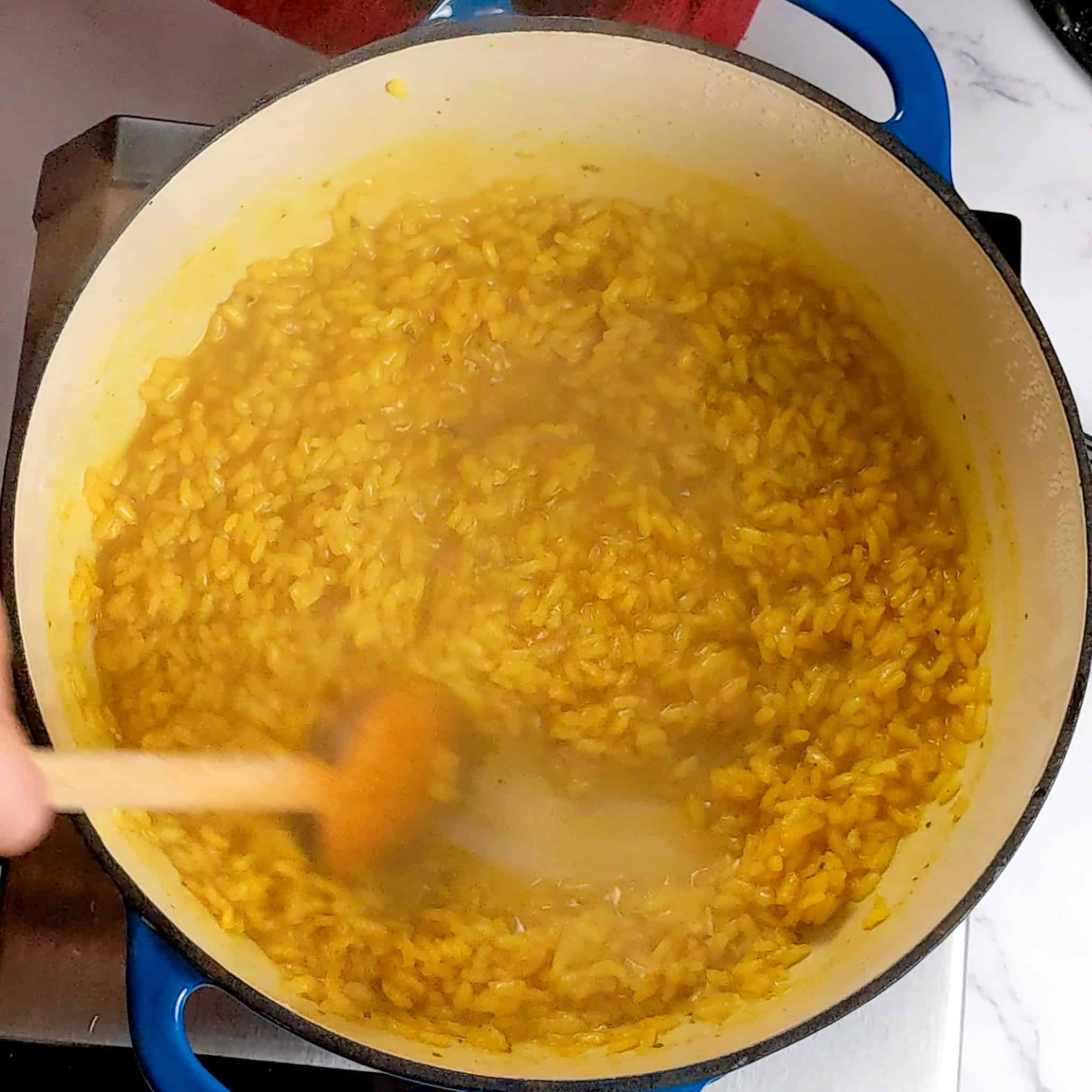
Test the risotto again to ensure most of the broth was absorbed; however, if you do not want the liquid to dry up too much, the rice should slowly return to the center.
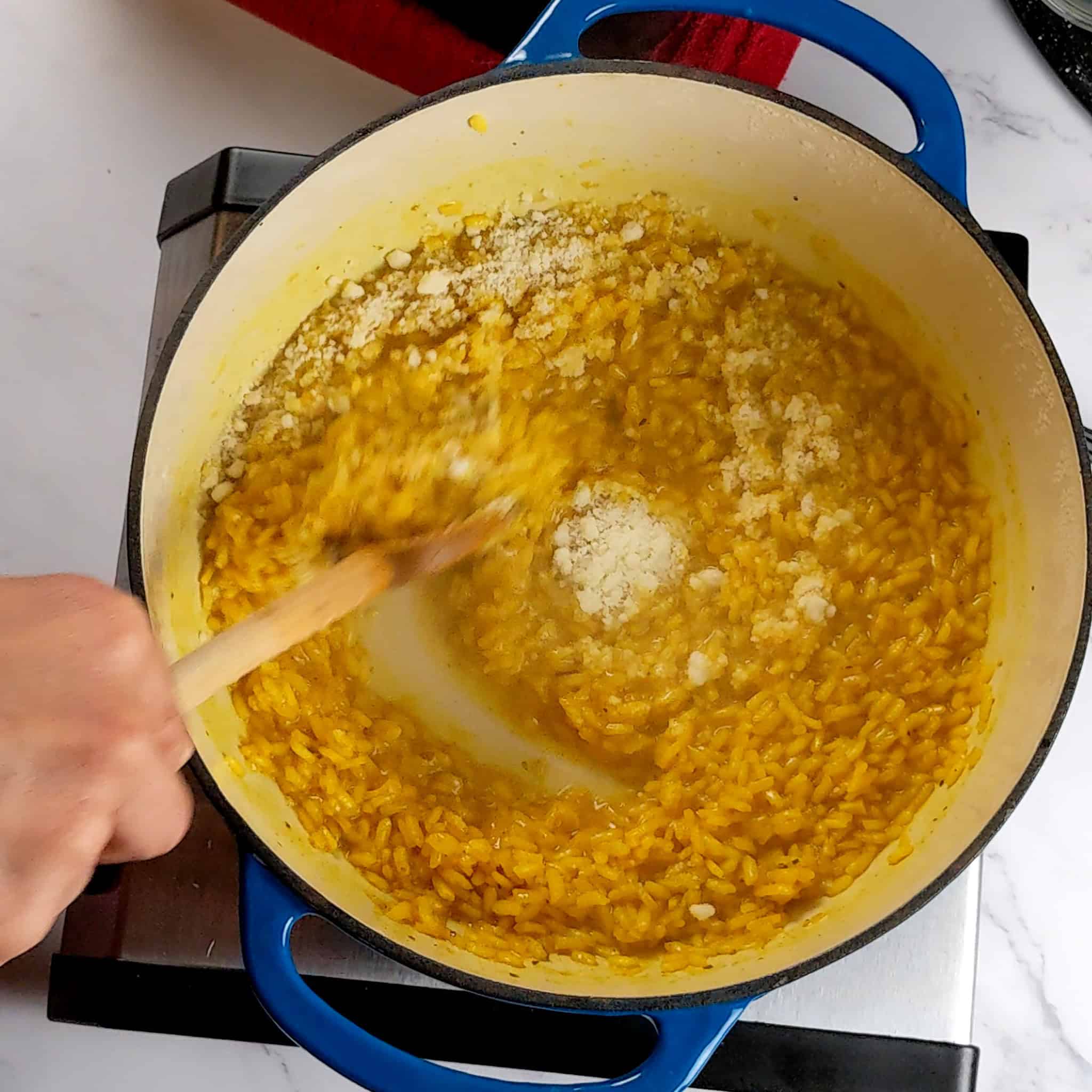
Add the cheese off the heat to prevent cheese from sticking to the bottom of the pot.
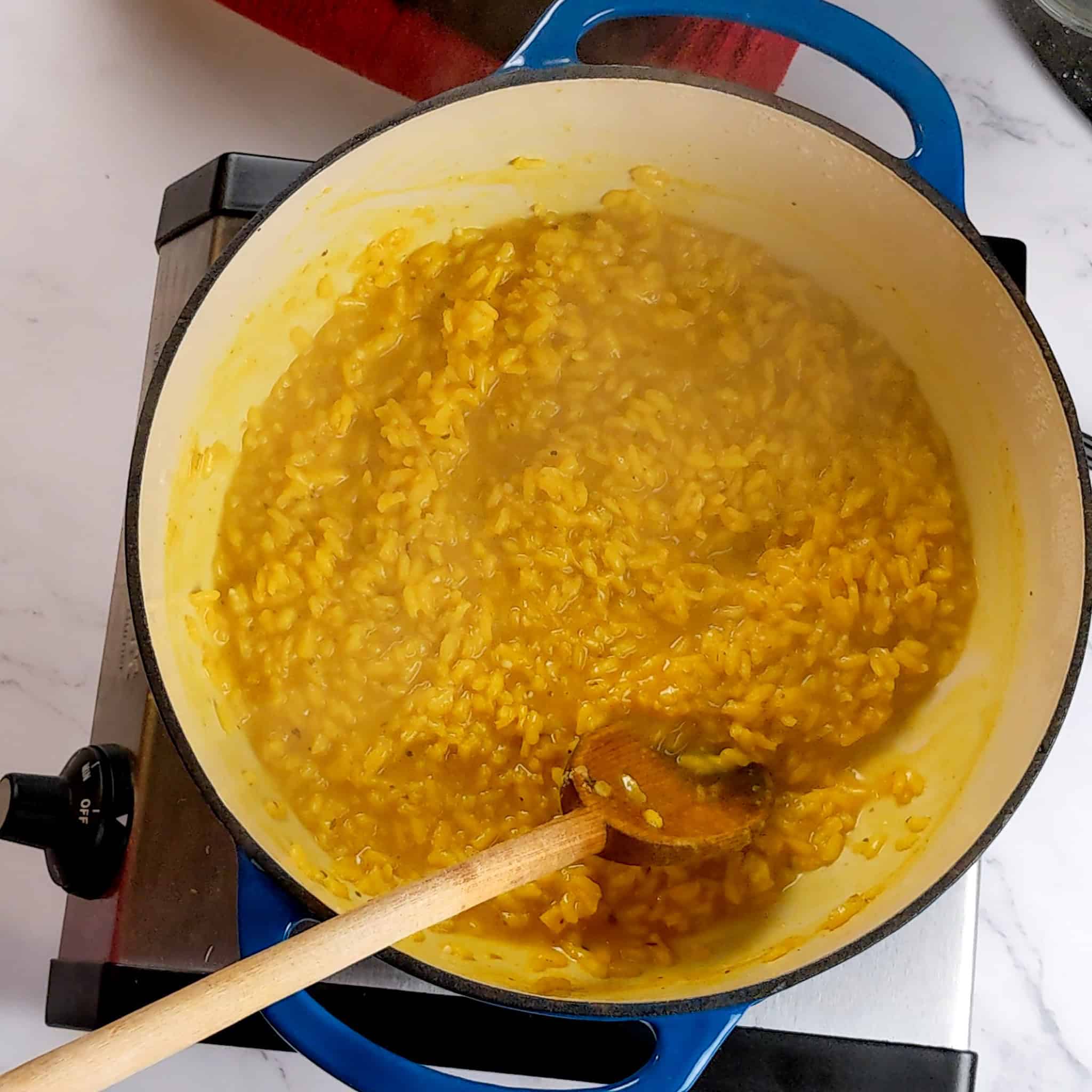
The risotto should be served immediately, or it will become solid from absorbing the liquid.
Substitutions
Dairy-Free
- Grated Italian Cheese Blend - Dairy-free grated Italian cheese blends are available online or at your local supermarket. Nutritional yeast, usually with a savory, earthy taste, is used as a substitute for grated cheese in plant-based meals.
Gluten-Free
- This recipe is already gluten-free!
Vegetarian
- Salmon Filet - To replace air-fried salmon with a vegetarian alternative, use thick slices of marinated tofu or tempeh at 375 degrees Fahrenheit until golden and slightly crisp. This will complement the asparagus and yellow risotto.
- Chicken Broth - You can use vegetable broth, but I suggest a light, not heavily roasted broth, as this type will give the risotto a distinctive flavor.
Convenience
- Adodo Wet Seasoning - Replace the smoked paprika, dried oregano, garlic powder, onion powder, ground cumin, kosher salt, and ground black pepper with store-bought adobo seasoning. Then, add the habanero, lemon, and oil as instructed in the recipe.
- Shallot - Use finely chopped onions instead.
- Chicken Broth - Use chicken bouillon with the water ratio recommended on the packet.
- Asparagus - Replace with hearty vegetables that cook simultaneously as the asparagus, like thick, colorful veggies of sliced zucchini or yellow squash and red bell pepper. Before adding it to the air fryer, you might have to par-cook steamed green beans, broccoli, or broccolini.
- Avocado Oil - In an air fryer, you usually use oils with high smoke points, such as avocado, canola, or peanut oil, to ensure even cooking and prevent burning. However, you can also use olive oil to make the risotto.
- Habanero Pepper Sauce - Use Scotch Bonnet Pepper Sauce to complement the adobo seasoning well.
Change Heat Level - Modify the recipe's heat level to your liking and learn more about the Scoville Scale and Chili Pairings. For example, for less heat, use pureed fire-roasted poblano peppers.
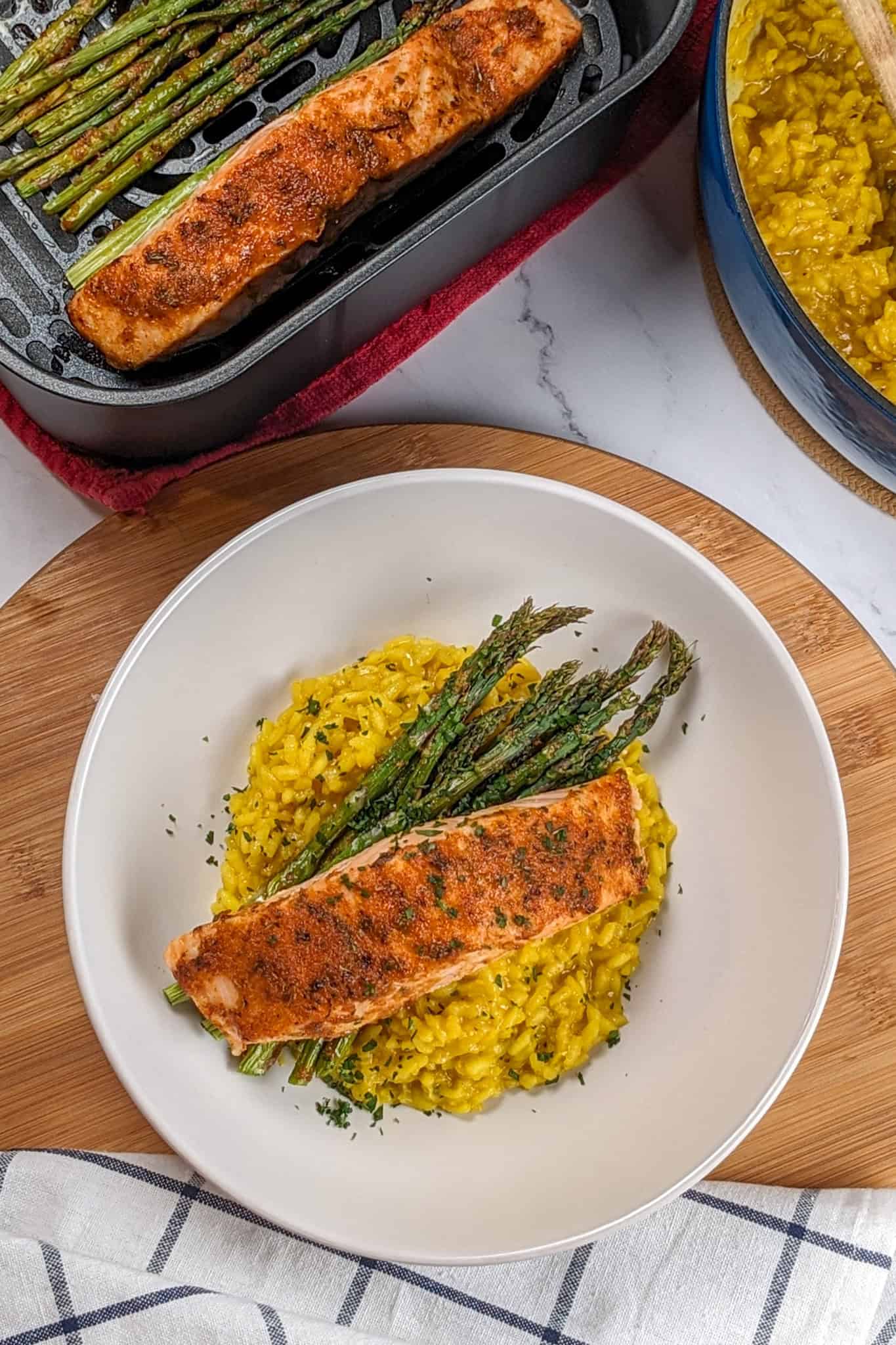
Variations
- Rotisserie Chicken - for an easy meal, Instead of salmon, try the wet adobo seasoning on store-bought chicken, using the same amount of air frying time. Or use boneless, skinless chicken breast. Salmon cooks faster than chicken breast. You will have to cook the chicken alone first. It can take 15 to 18 minutes. Add the asparagus when it is down to 7 to 8 minutes of cooking time.
- Different Side Dish - If you do not wish to eat this with risotto, you can make a different type of rice, such as white rice or aromatic steamed jasmine rice. This will also work with brown basmati rice or leftover rice with turmeric, adobo's warm spices, and lemon zest.
Equipment
- Dutch Oven - Using an enameled Dutch oven for cooking risotto provides excellent heat retention and even distribution, ensuring a perfectly cooked, creamy texture without the risk of scorching. This great recipe was developed using the Lodge Enamel Dutch Oven.
- Air Fryer - Cooking fresh fish using an air fryer is a quick and healthy method that results in a crispy exterior and moist interior. It requires less oil than traditional frying and takes less cooking time, making it a more convenient option. This recipe was developed using the Cosori Turbo Blaze Air Fryer to create this quick dinner. Cooking Salmon in the Oven: To cook salmon in the oven, preheat to 400°F, place the salmon skin-side down on a lined baking sheet, with wet adobo seasoning on top, and bake for 12-15 minutes or until the flesh is opaque and flakes easily.
Kitchen Must Haves - Find other tools I use here.
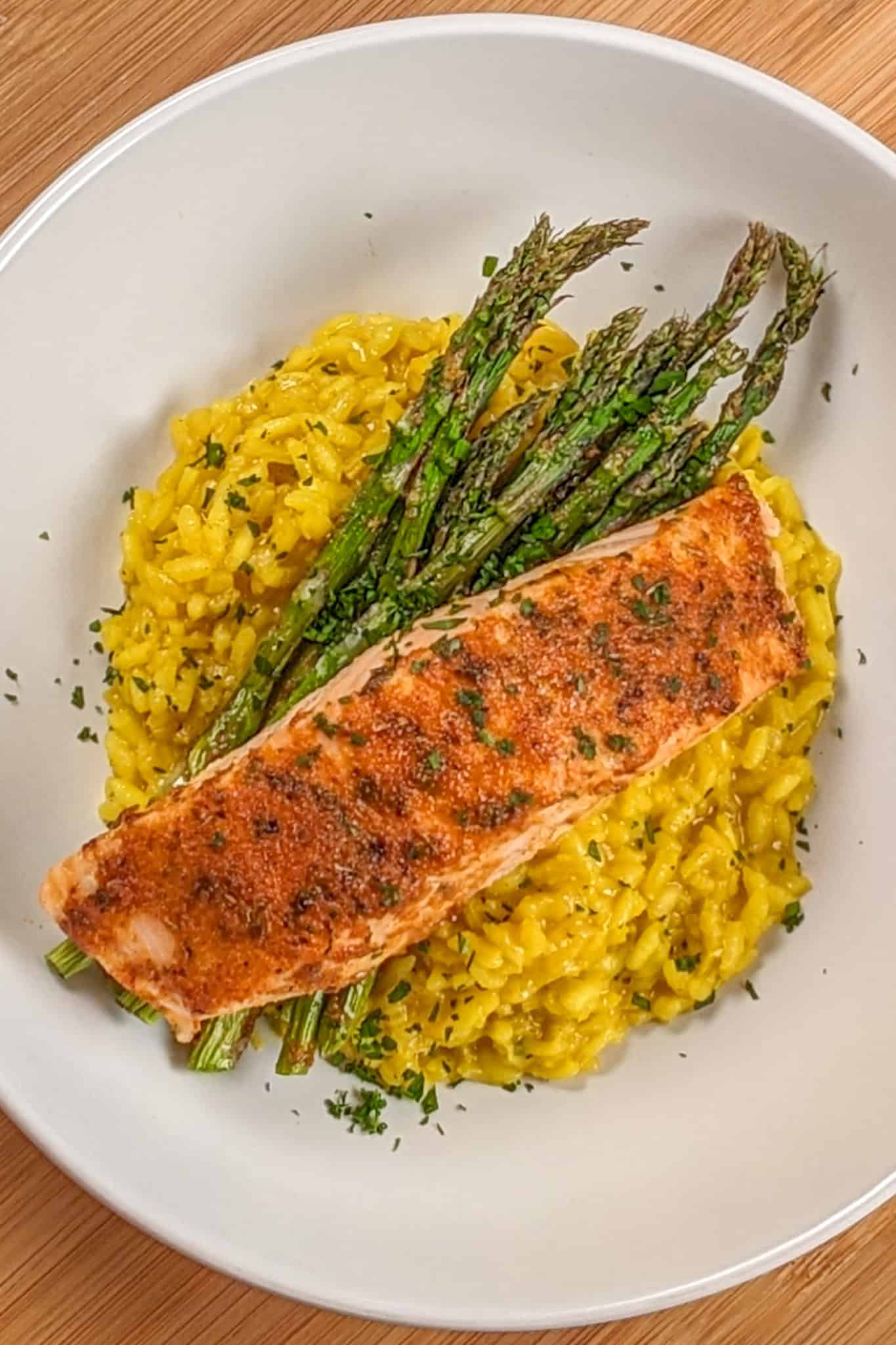
Storage
- Refrigerator - To store the risotto and salmon in the fridge, place them separately in a shallow 2-inch container to cool down quickly. Then, store it in an airtight container. The risotto will last up to four days, while the salmon will last up to two days.
- Freezer - Follow the refrigeration process mentioned above. Then, place it in the freezer in a labeled, airtight container.
Airtight Food Containers - I interchange glass food storage containers with plastic clipping lids or wooden push-ins. I always suggest glass storage containers because they can be microwaved, they hold food without staining, and the glass keeps the food at a more stable temperature, keeping it fresher and longer.
Try the OXO Good Grips Smart Seal Glass Rectangle Food Storage Containers or the Pyrex Freshlock Glass Food Storage Containers.
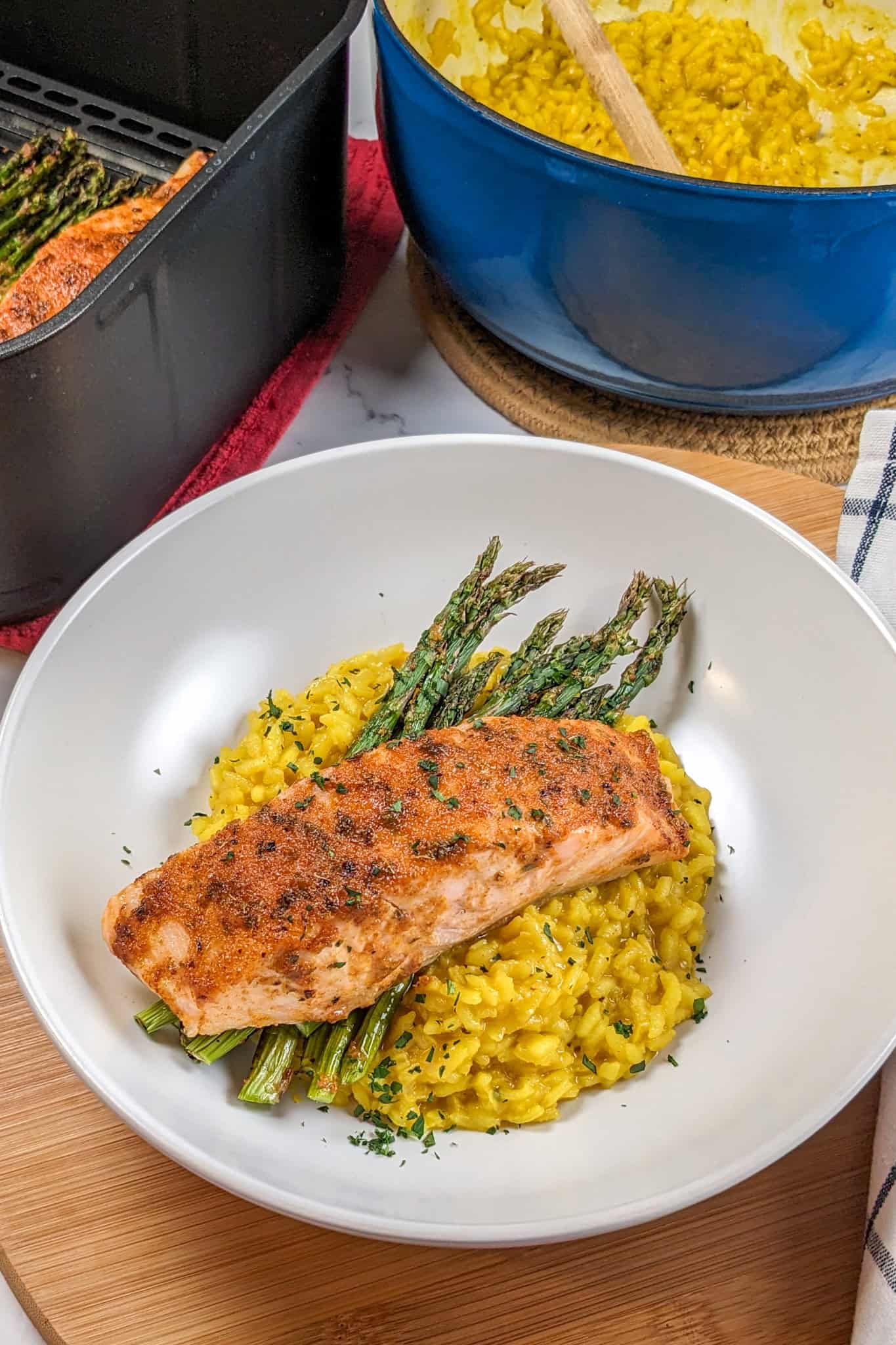
Cooking Tip
- Thick Risotto Problem - For best results, serve the risotto immediately before it becomes too thick! To loosen a thickened risotto, gently stir in a bit of warm broth until it reaches your desired creamy consistency.
Your Cooking Tips Resource Guide - Become a better home cook with tips to help you cook more efficiently on the Cook's Notebook tab.
Frequently Asked Questions
Arborio rice is the most popular choice for making risotto due to its high starch content, which helps to create the dish’s signature creamy texture. Other varieties like Carnaroli or Vialone Nano are also excellent options, offering slightly different textures and flavors but similar creaminess.
While risotto doesn't require non-stop stirring, frequent stirring is crucial to achieving the classic creamy texture. Stirring helps to release the rice's starches, thickening the surrounding liquid. It's especially important to stir when adding new ladles of broth to prevent sticking and ensure even cooking.
While it's unnecessary to use oil when air frying vegetables, adding a small amount is a great way to enhance the flavor, improve texture, and help achieve a more even golden color. Lightly coating your vegetables in a teaspoon or two of oil before air frying can also help seasonings stick better, resulting in tastier, crispier outcomes.
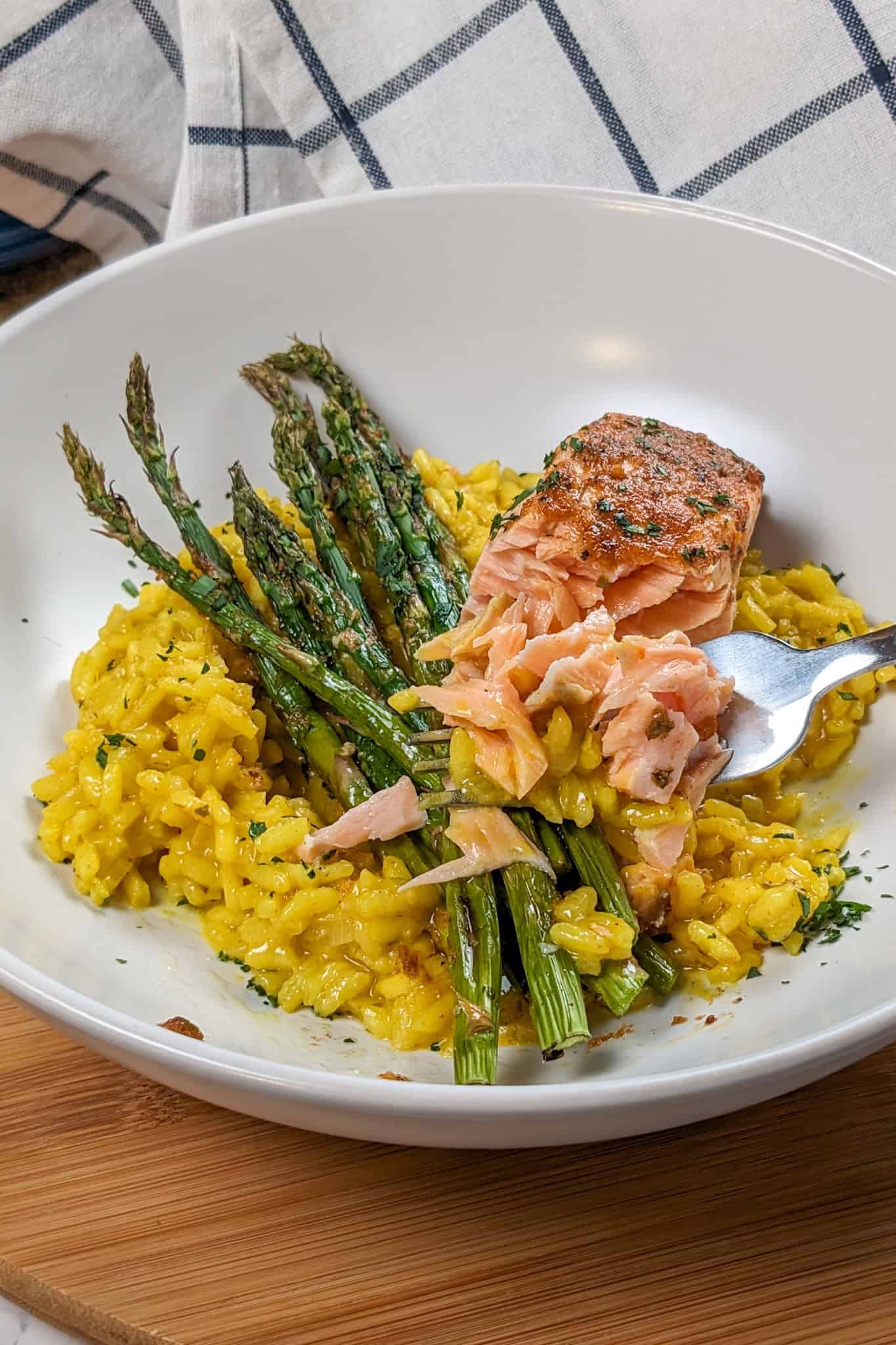
Seafood Recipes
Looking for other seafood recipes like this? Try these:
- Healthy Haitian-Style Creole Spicy Shrimp Pasta
- Seared Snapper Spicy Creole Sauce and Roasted Vegetables
- Sesame Seed-Crusted Ahi Tuna with Spicy Sesame-Soy Sauce
- Grilled Shrimp Garlic Jalapeno Butter and Cilantro Lime Rice
Air Fryer Recipes
Looking for other air fryer recipes like this? Try these:
- Beituti Chicken Shawarma Rice Bowl | Quick and Easy
- Air Fryer Chicken Shawarma | Quick with Beituti
- Easy 15-Minute Marinade for Beef Kabobs
- Grilled Zhug Ras El Hanout Lamb Chops and Tomato Salad
📖 Recipe
Best Air Fryer Habanero Adobo Salmon and Yellow Risotto
Ingredients
Adobo Wet Seasoning
- ½ teaspoon smoked paprika
- ½ teaspoon dried oregano
- ½ teaspoon garlic powder
- ¼ teaspoon onion powder
- ¼ teaspoon ground cumin
- ½ teaspoon kosher salt
- ¼ teaspoon ground black pepper
- 1 teaspoon habanero sauce
- 1 medium lemon
- 1 tablespoon avocado oil
Yellow Risotto
- 1 shallot
- 2 garlic cloves
- 1 tablespoon avocado oil
- ¾ cup arborio rice
- ¼ cup white wine preferably Sauvignon Blanc
- 2 cups low-sodium chicken broth
- ½ teaspoon ground turmeric powder
- ½ teaspoon kosher salt
- ¼ teaspoon ground black pepper
- ¼ cup grated Italian cheese blend
Salmon and Asparagus
- 8 ounces of salmon filet 4 ounces filets per serving
- ½ bunch of asparagus 6 ounces per serving
- parsley for garnish optional
Equipment
Instructions
- Save time in the kitchen: Read the instructions thoroughly, then gather and prep all your ingredients before cooking! Learn Prepping Tips.
- Make the Adobo Wet Seasoning: Combine paprika, oregano, garlic powder, onion powder, cumin, kosher salt, and ground black pepper—Reserve 1 teaspoon for the risotto preparation. And finish the wet seasoning wtih habanero sauce, avocado oil, half of the lemon juice, and half of the zest, and set it aside with a brush.
- Prep the Asparagus: Cut 1-½ inch of the asparagus' bottom and set them aside.
- Prep the Aromatics: Small chop the shallot and garlic.
- Make the Yellow Risotto: Heat the oil in a Dutch oven on medium heat. Add the shallot and garlic mixture and sweat until halfway tender, stirring occasionally to prevent browning, for 1 minute. Then, add the arborio rice and fry in the aromatics and oil for 3 minutes while stirring occasionally to prevent browning.
- Add the white wine, stir until evaporated, and lower the heat to low. Once the wine is absorbed, add half of the chicken broth, turmeric powder, salt, pepper, and reserved adobo seasoning.
- Stir occasionally while the liquid is being absorbed. Stirring allows the starch from the arborio rice to thicken the broth. When the liquid is absorbed, stir in half of the remaining broth and repeat.
- Add and stir the remaining broth, cover, and simmer on low heat when the liquid is absorbed. While the risotto simmers, prepare to cook the salmon and asparagus in the next step.
- Set the Air Fryer: Preheat the air fryer to 375 degrees Fahrenheit and cook for 7 minutes.
- Prepare the Salmon and Asparagus: Pat the salmon dry wtih a paper towel. When the air fryer is ready, place the salmon on the outer sides of the air fryer basket and spread one even layer of asparagus in the middle. Brush both the salmon and asparagus with the wet seasoning. Place the rest of the asparagus and brush with the remaining seasoning.
- Cook the Salmon and Asparagus: Cook in the air fryer at 375 degrees Fahrenheit for 7 minutes, depending on the thickness of the salmon and asparagus. If they are not done, cook for another 2 to 3 minutes.
- Salmon is done at an internal temperature of 145 degrees Fahrenheit, firm when touched, and flaky with a fork test.
- Finish the Yellow Risotto: When the rice is tender but firm (al dente), add half of the remaining lemon juice, all the zest, and the cheese blend. Taste for salt and lemon flavor and adjust accordingly.
Video
Notes
- For Convenience - Use store-bought adobo seasoning
- ¾ cup = ½ + ¼ cup
- Grated Italian Cheese blend usually consists of pecorino and/or parmesan cheese. It can be used interchangeably in this recipe.
- Traditional Adobo Seasoning using chili powder was omitted in this recipe.
Nutrition
Subscribe to my YouTube Channel.
SUBSCRIBE: 👈To my YouTube Channel to Get Notifications of New Videos.
Have a Comment or Question?
If you have a question or comment about this recipe, please post it below. You will definitely get a quick response. It also helps our other readers to stay informed. Thanks!

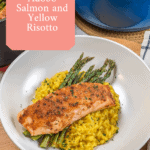
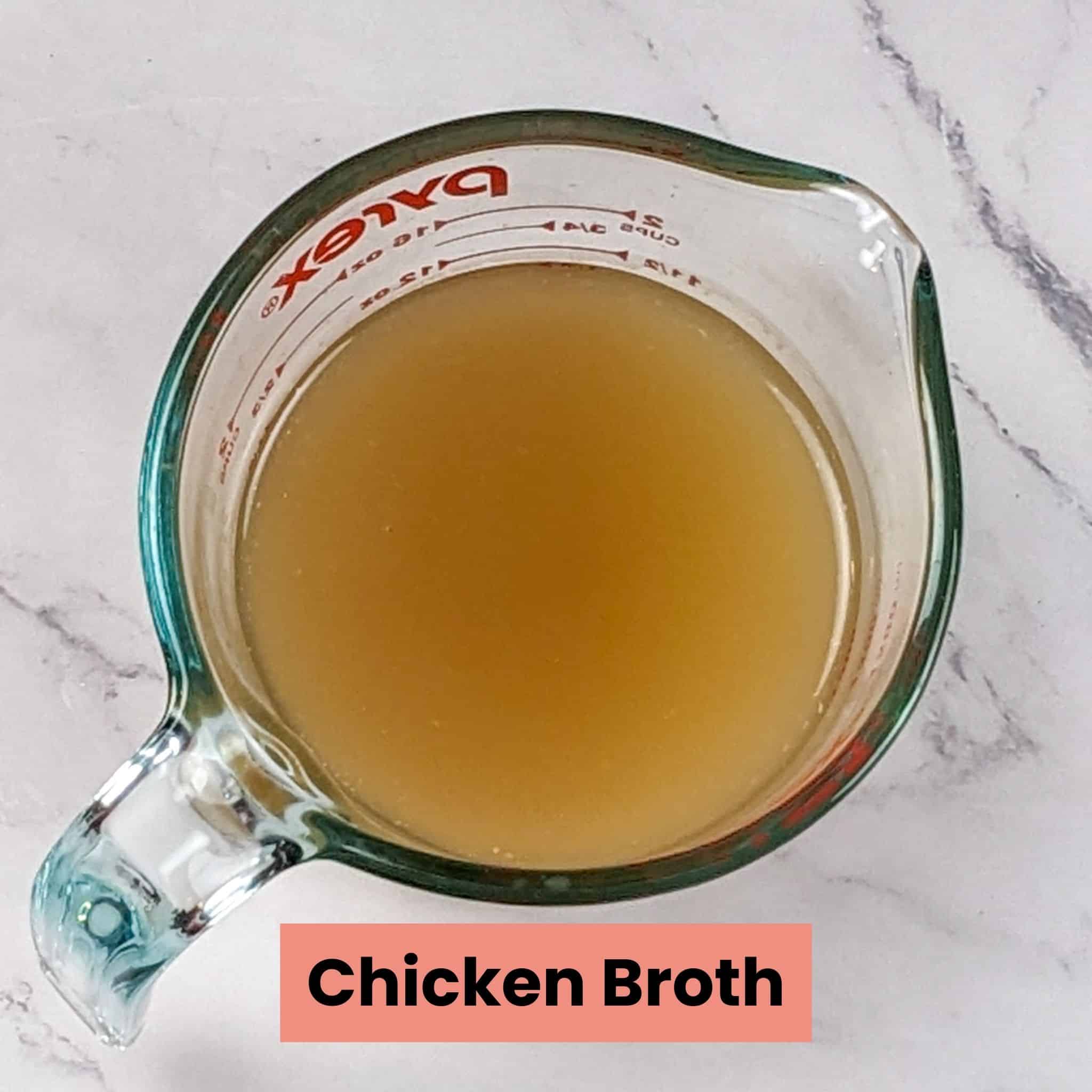
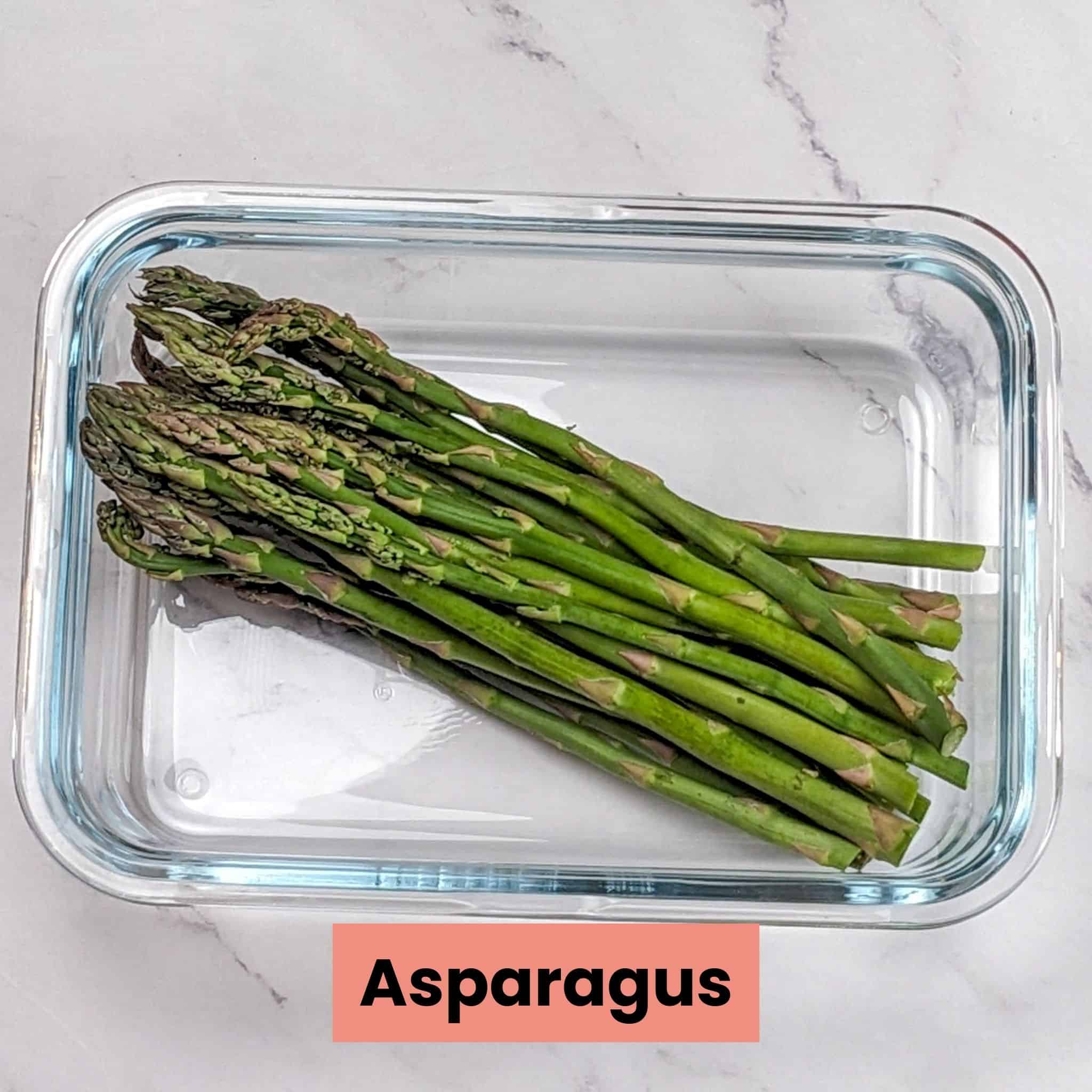
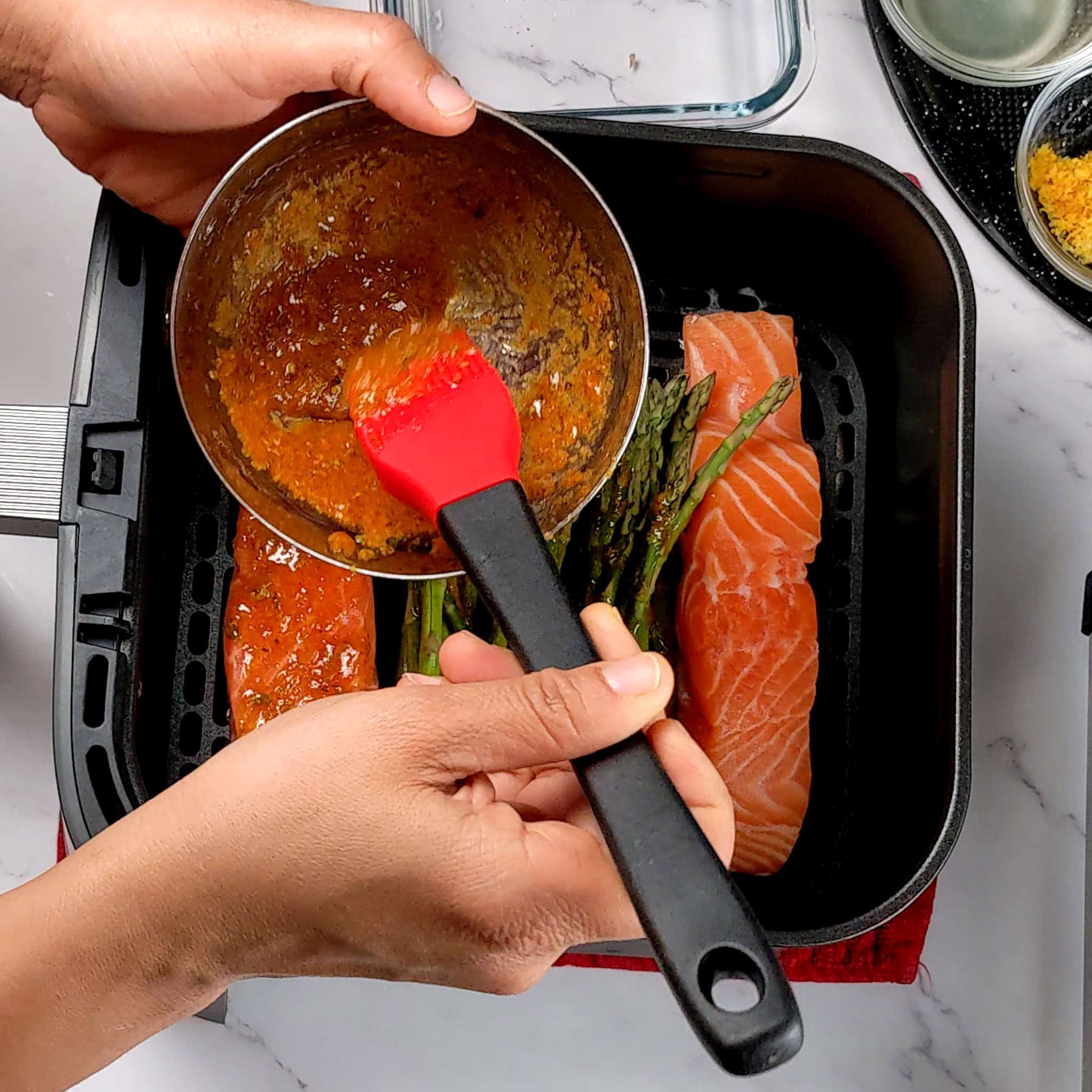
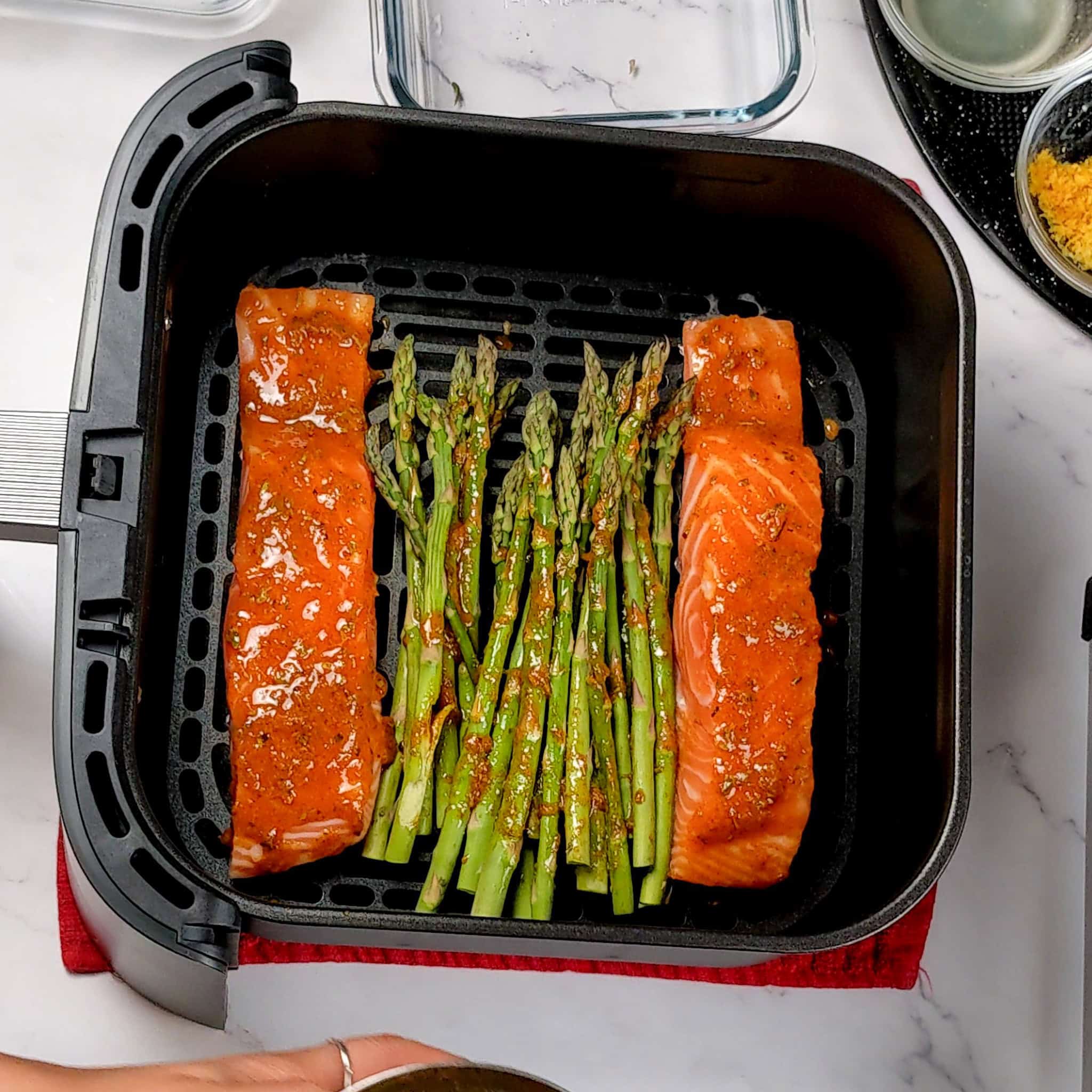
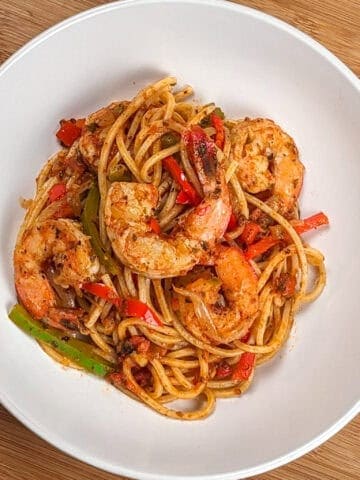
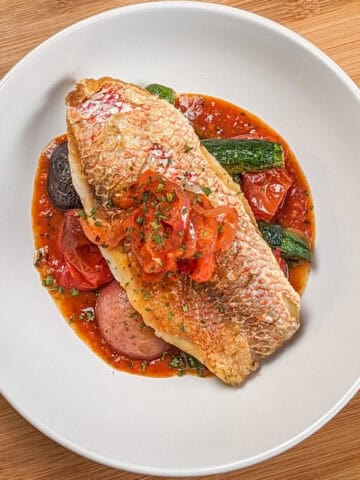
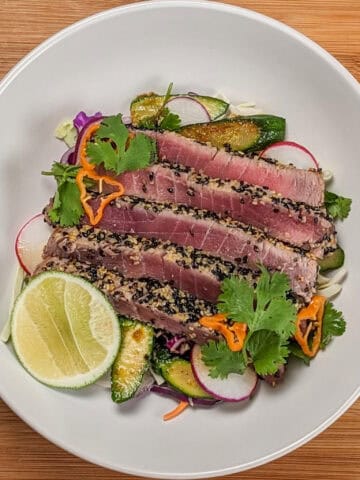
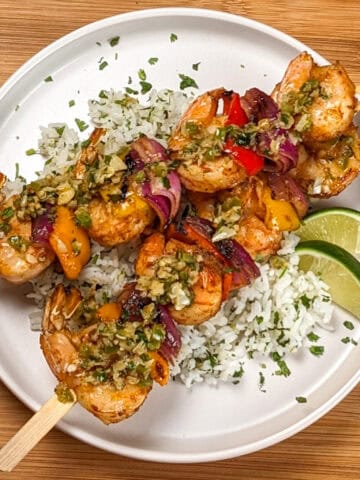
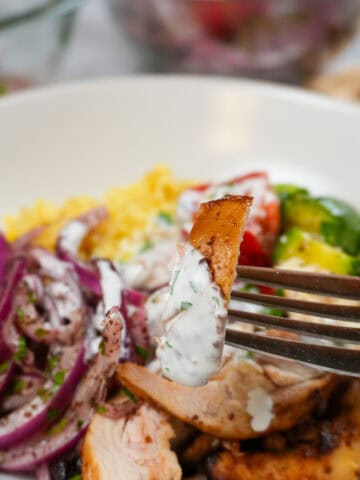

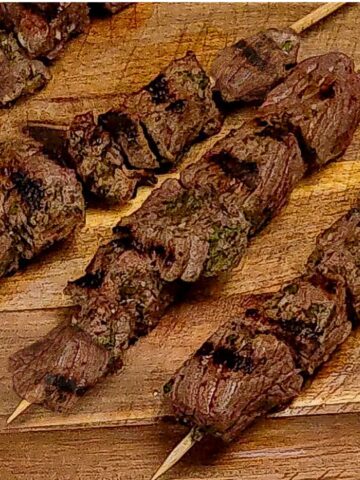
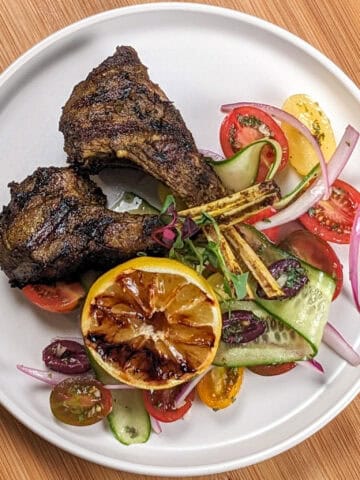

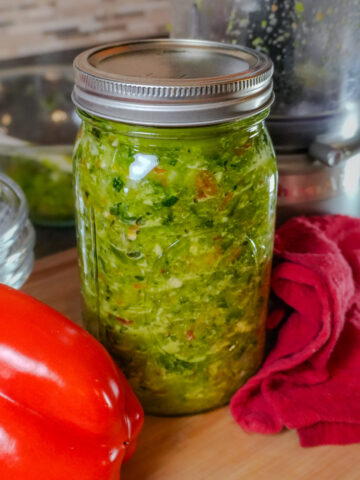
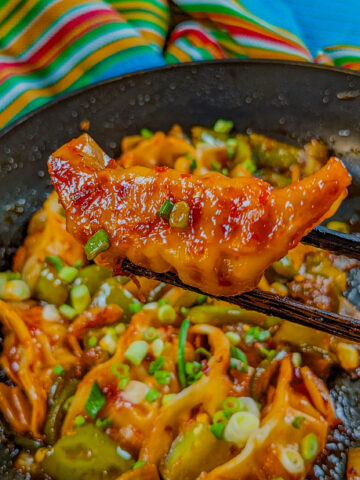
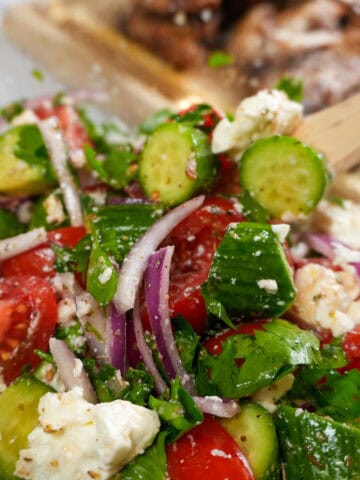
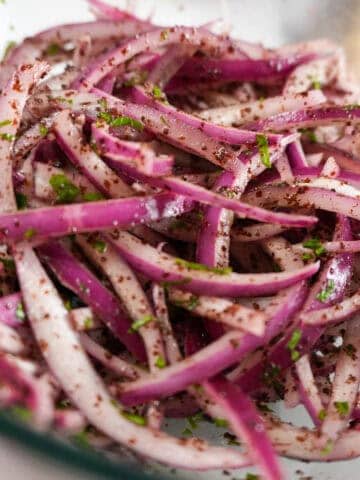
Leave a Reply